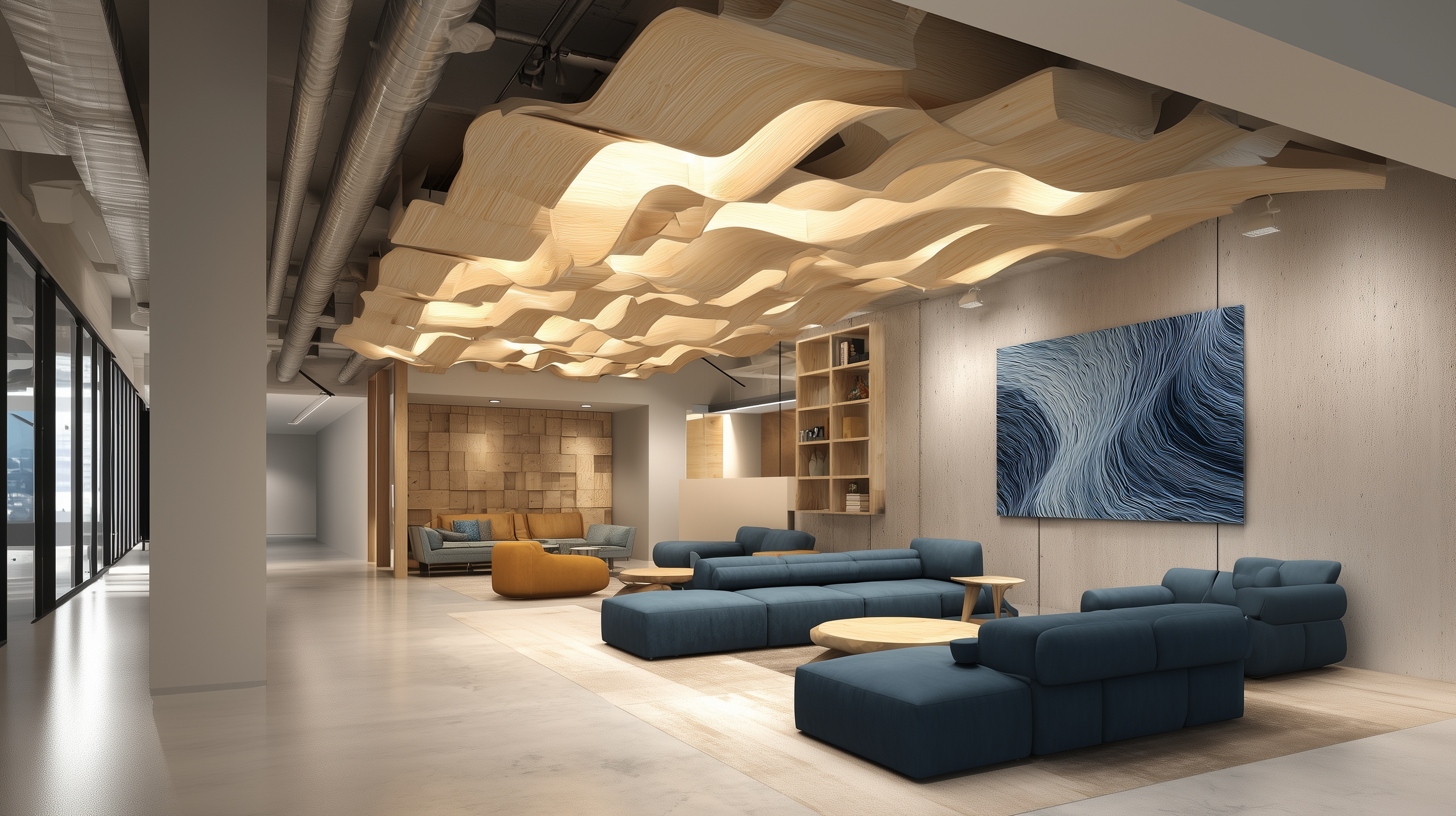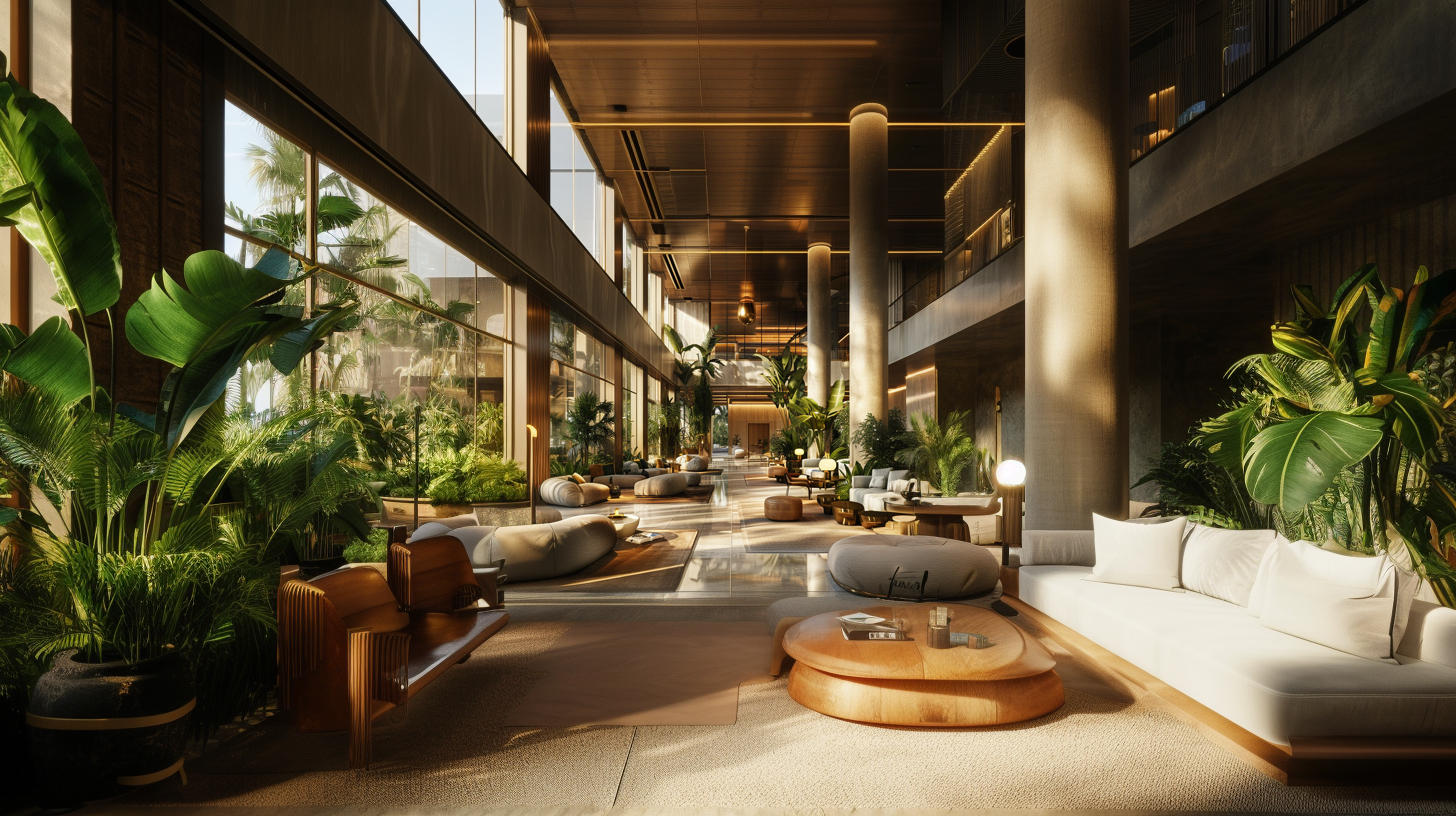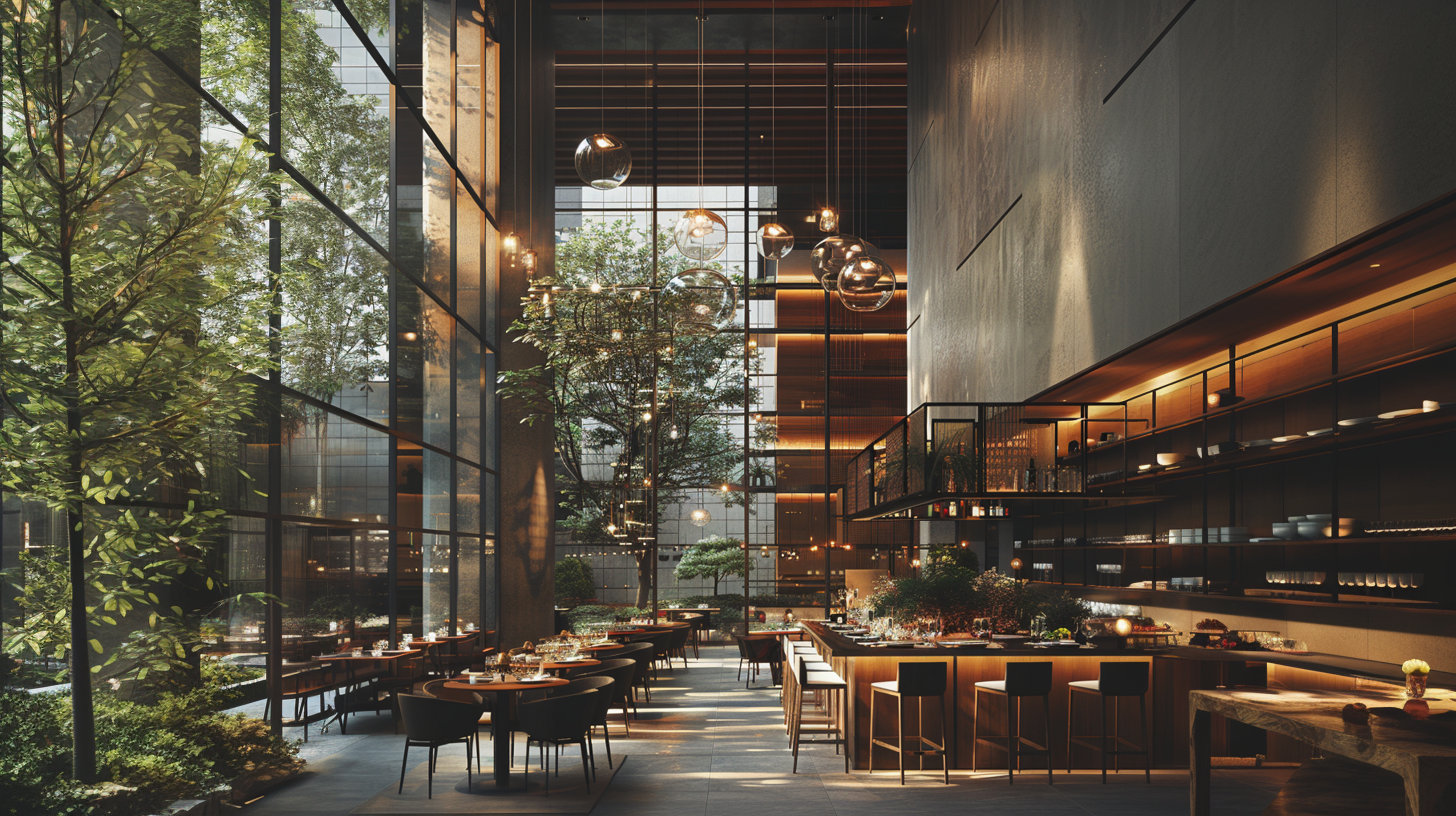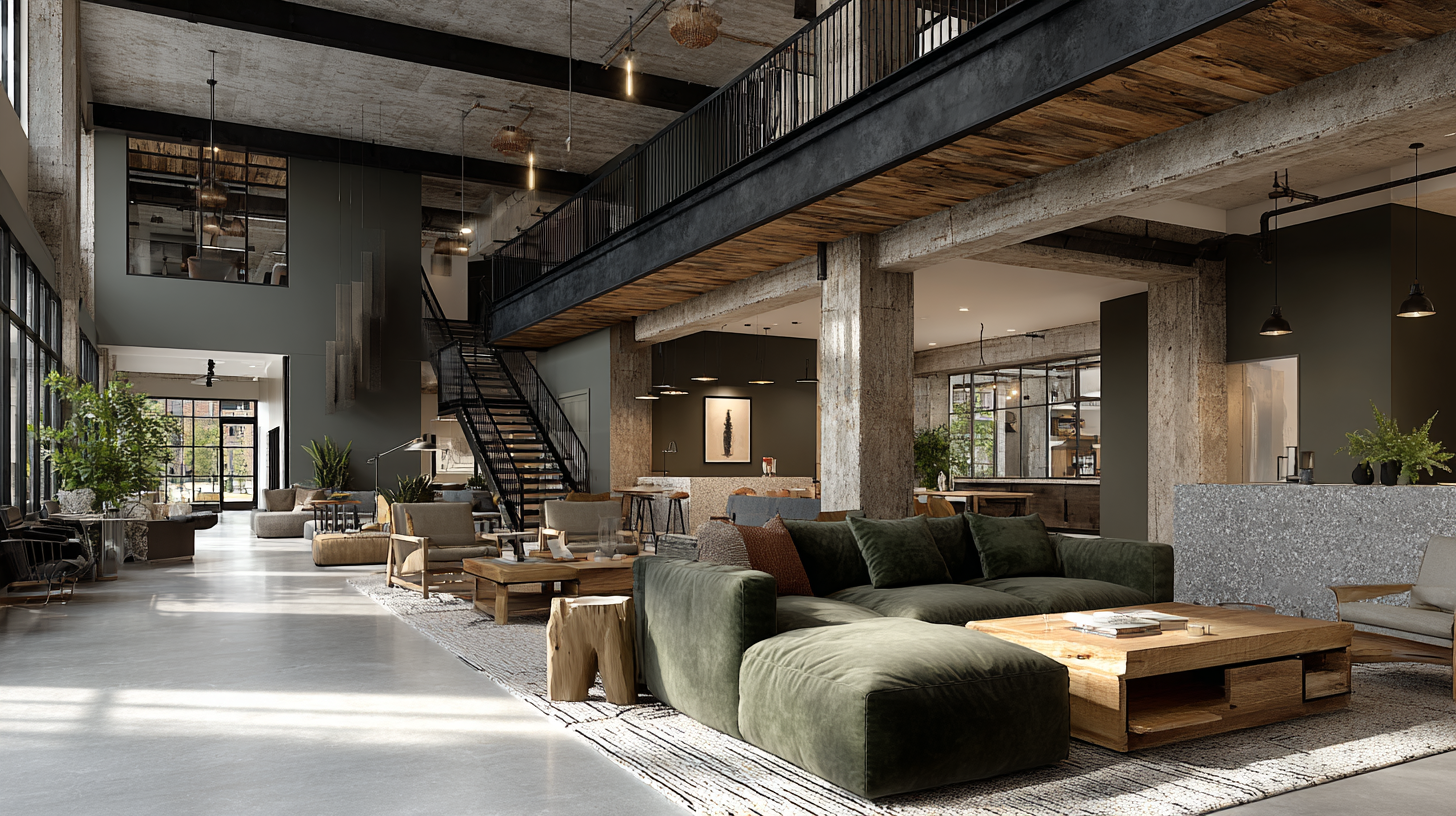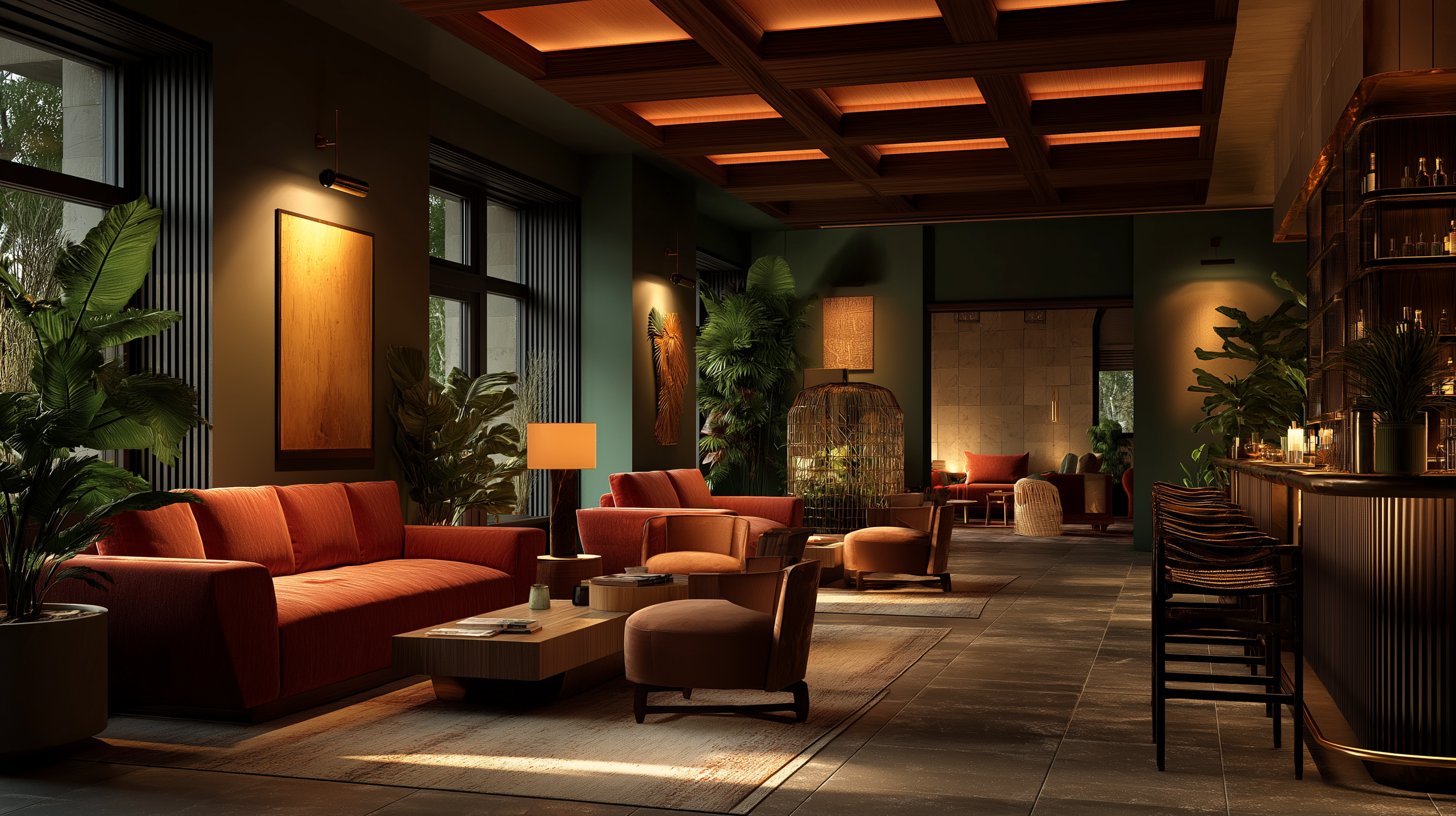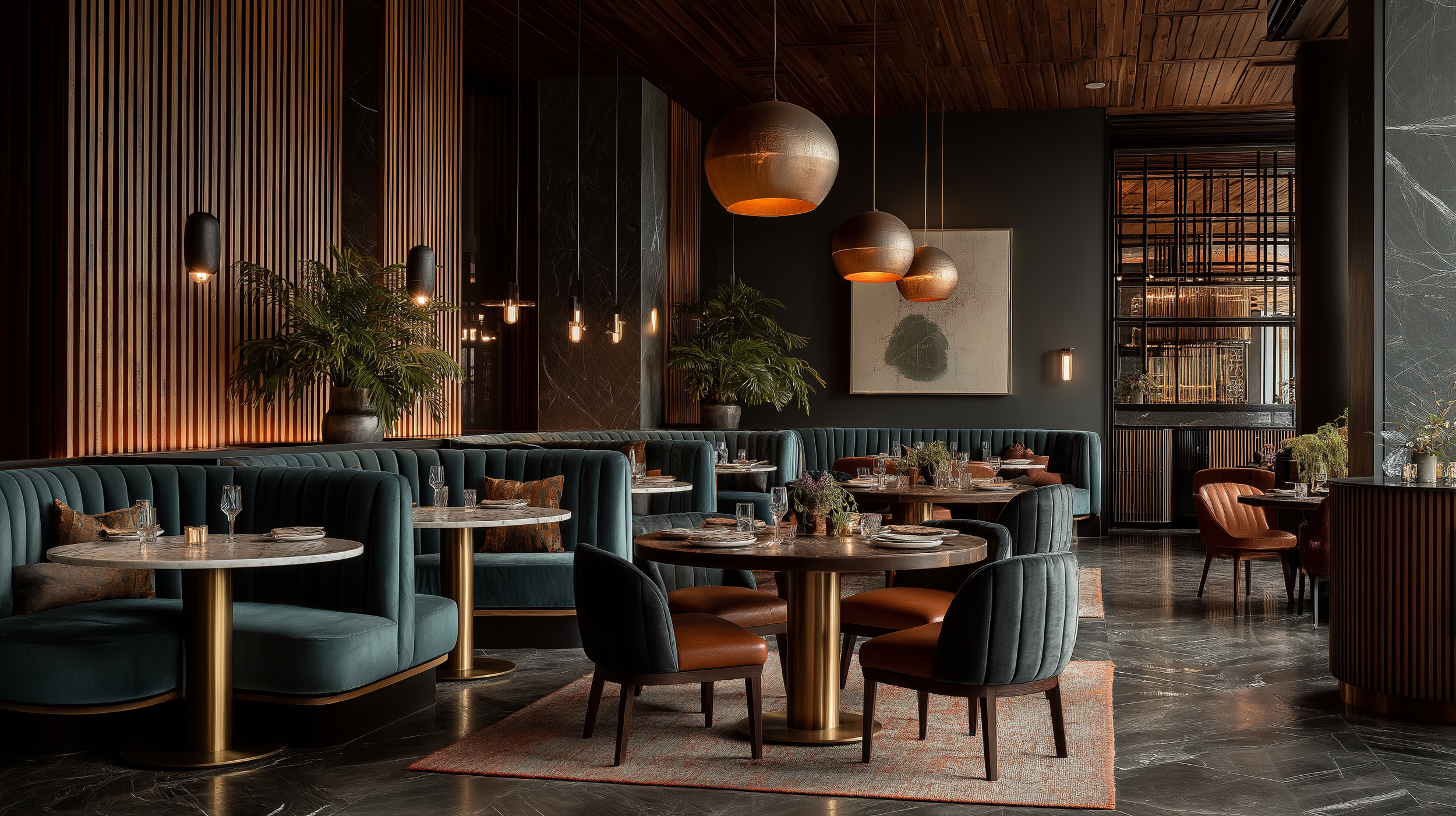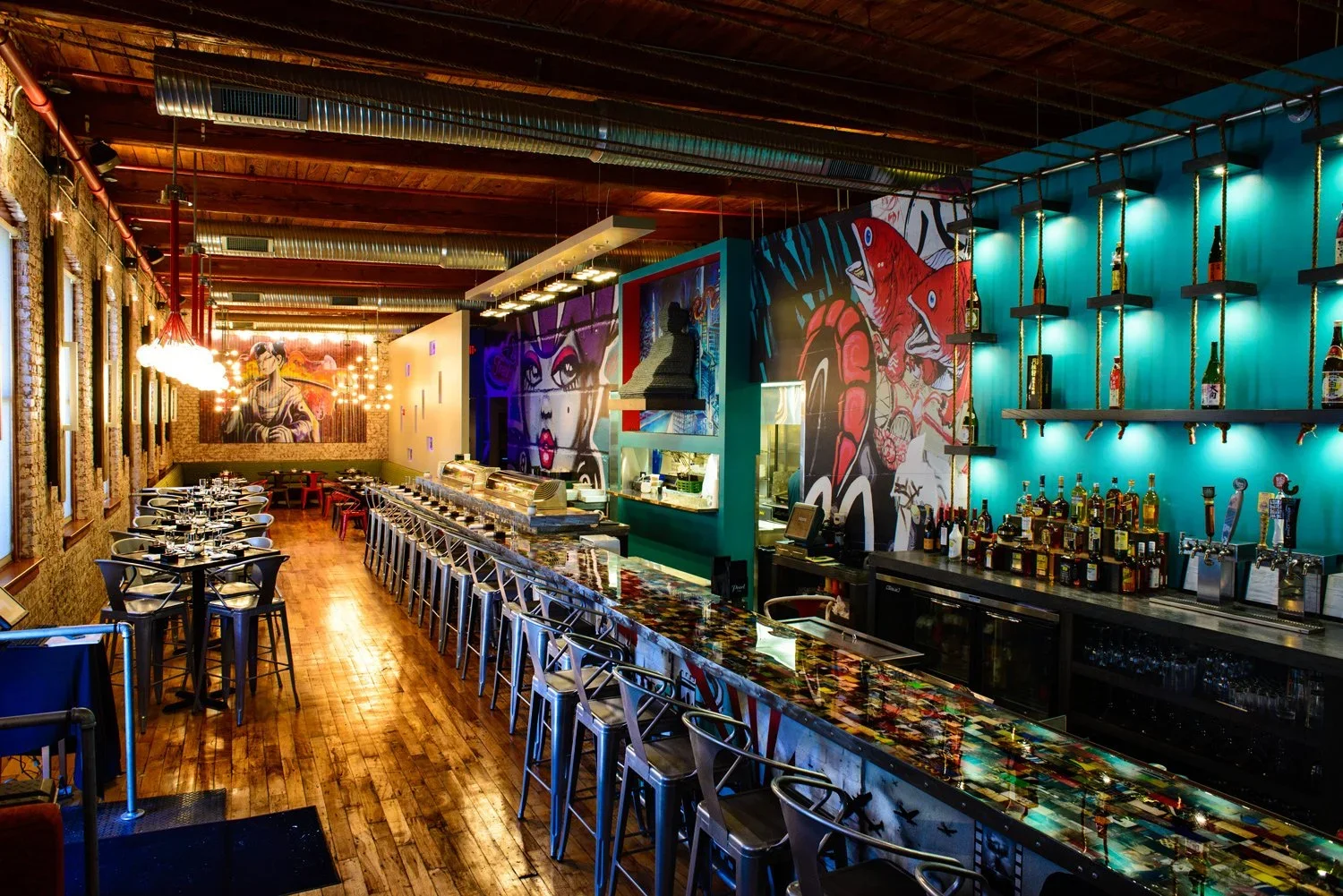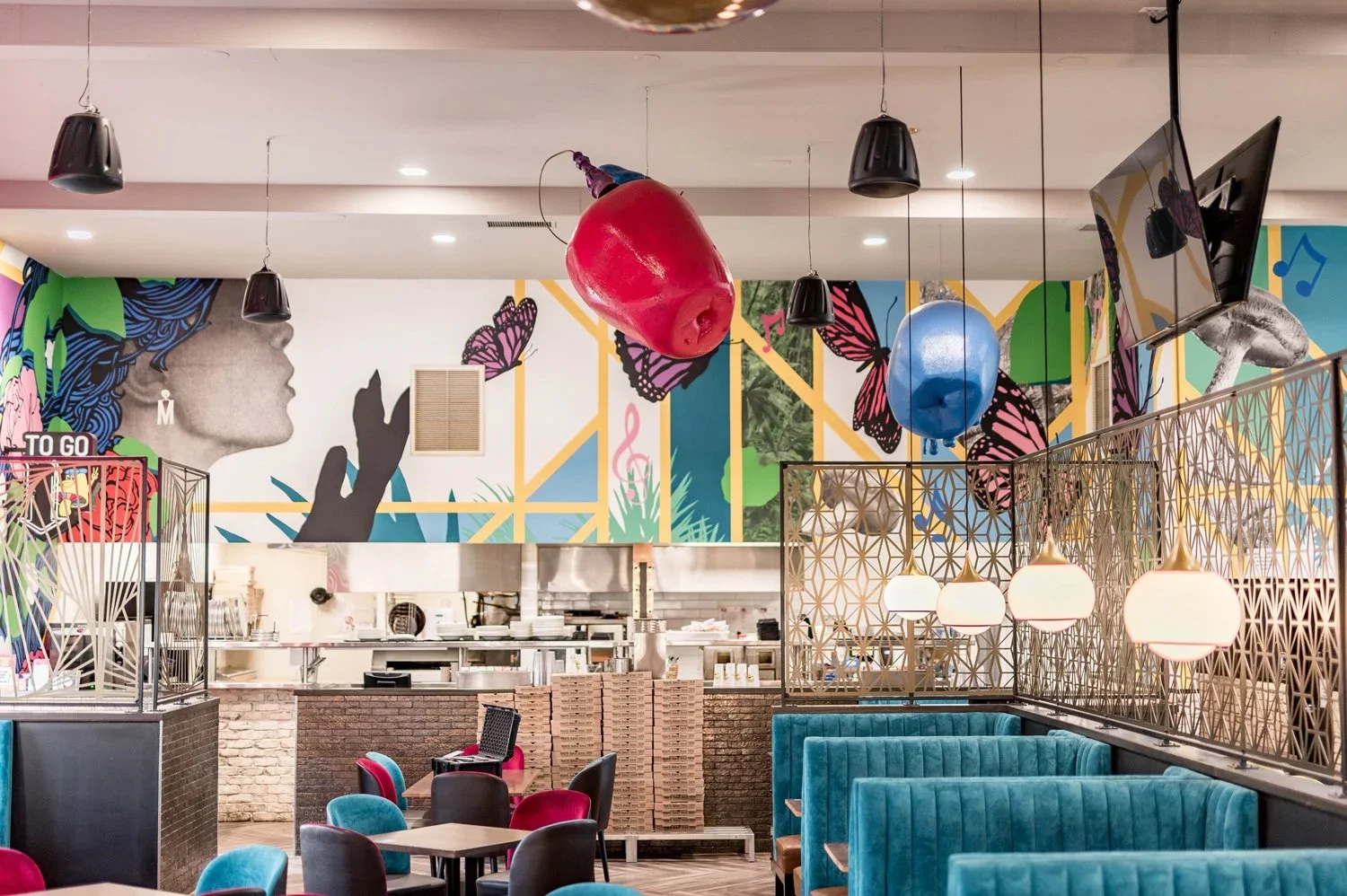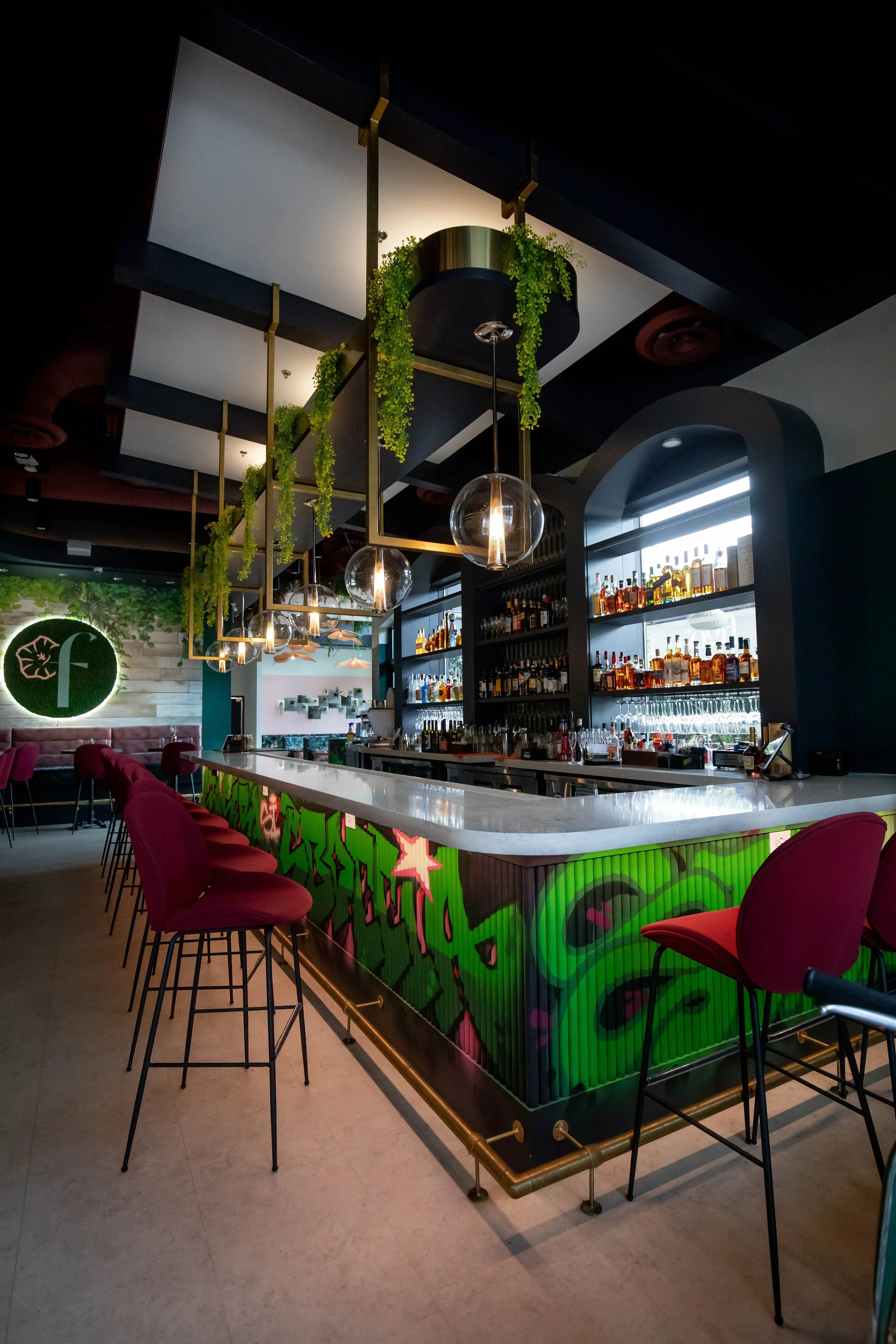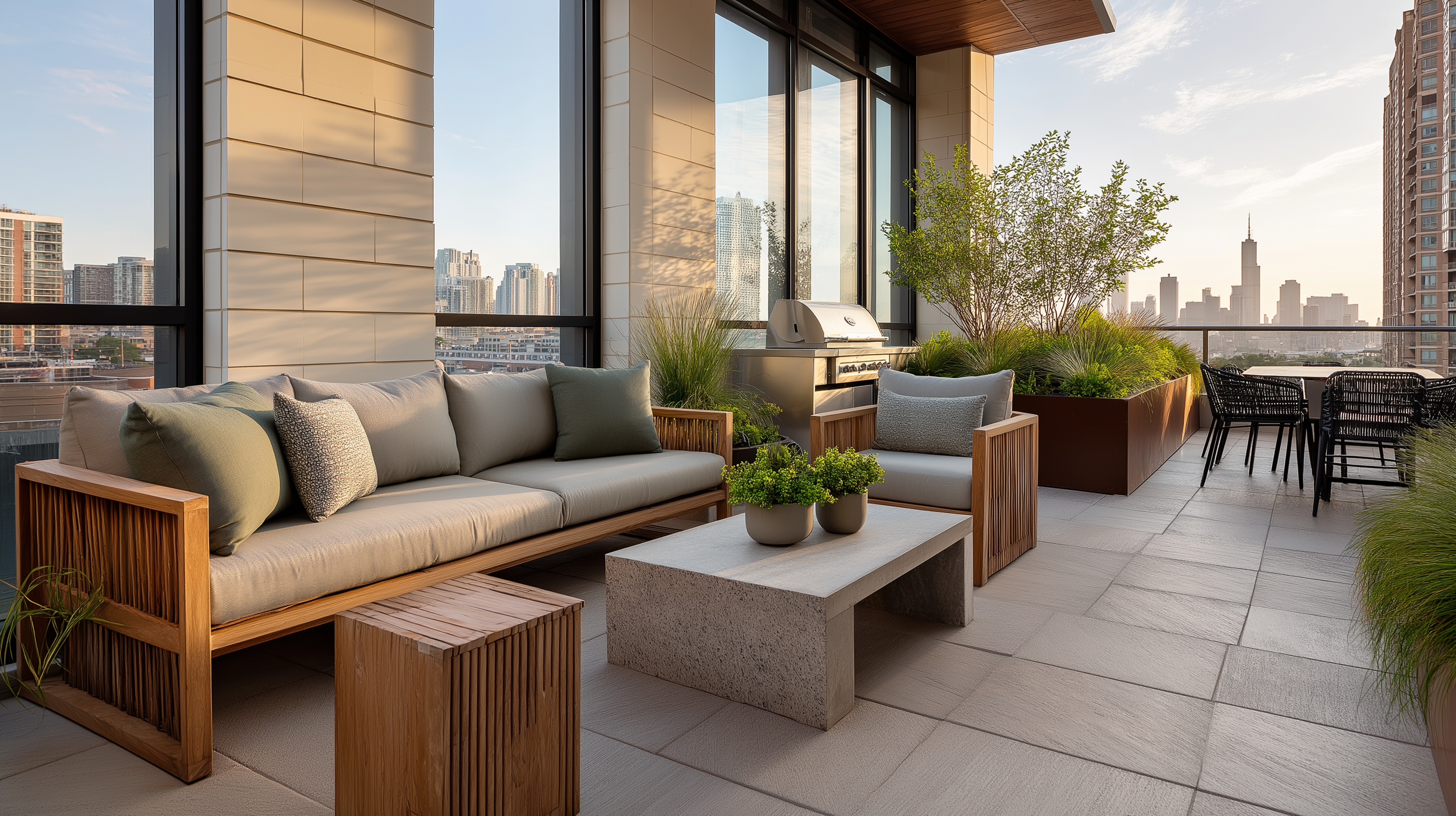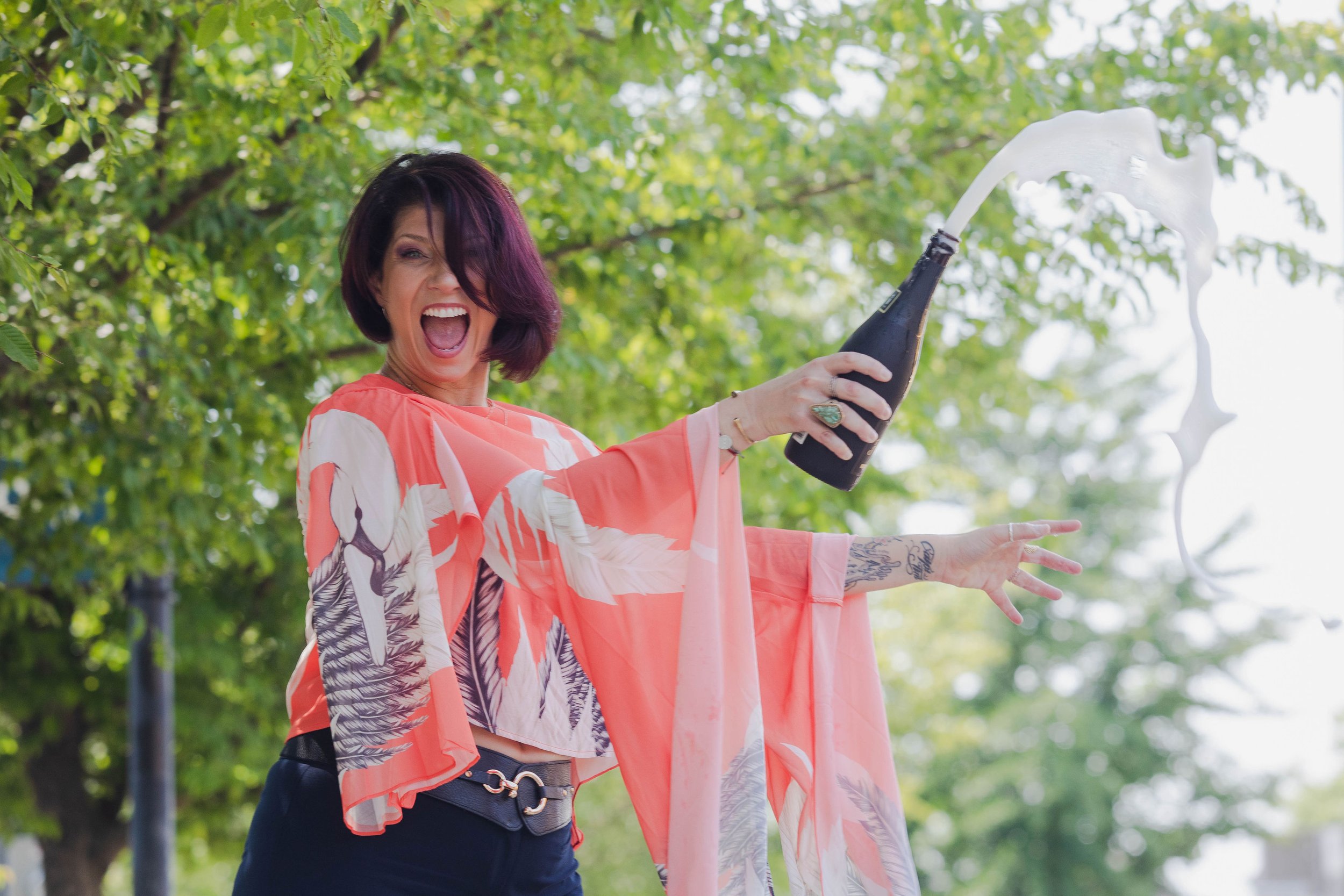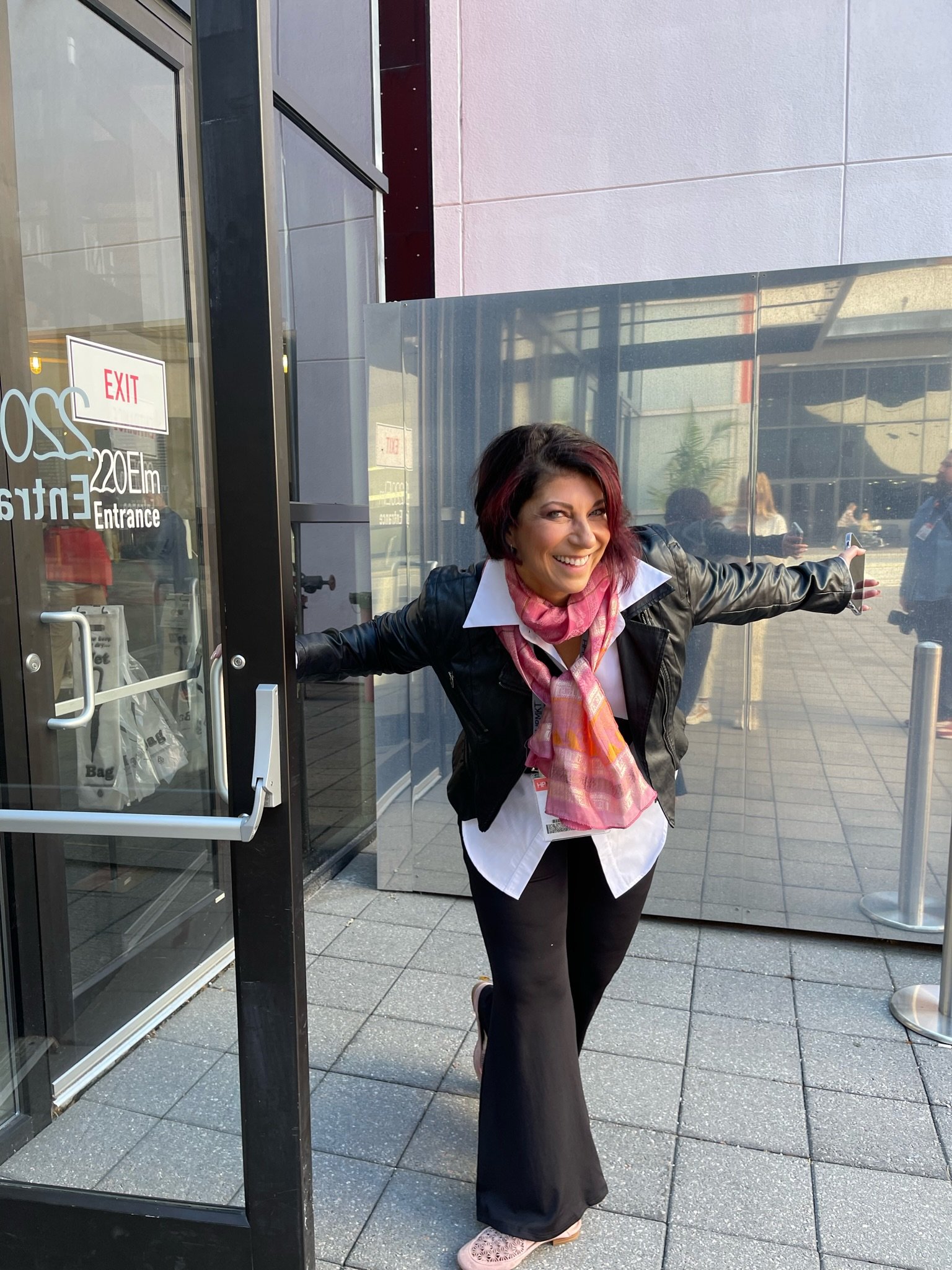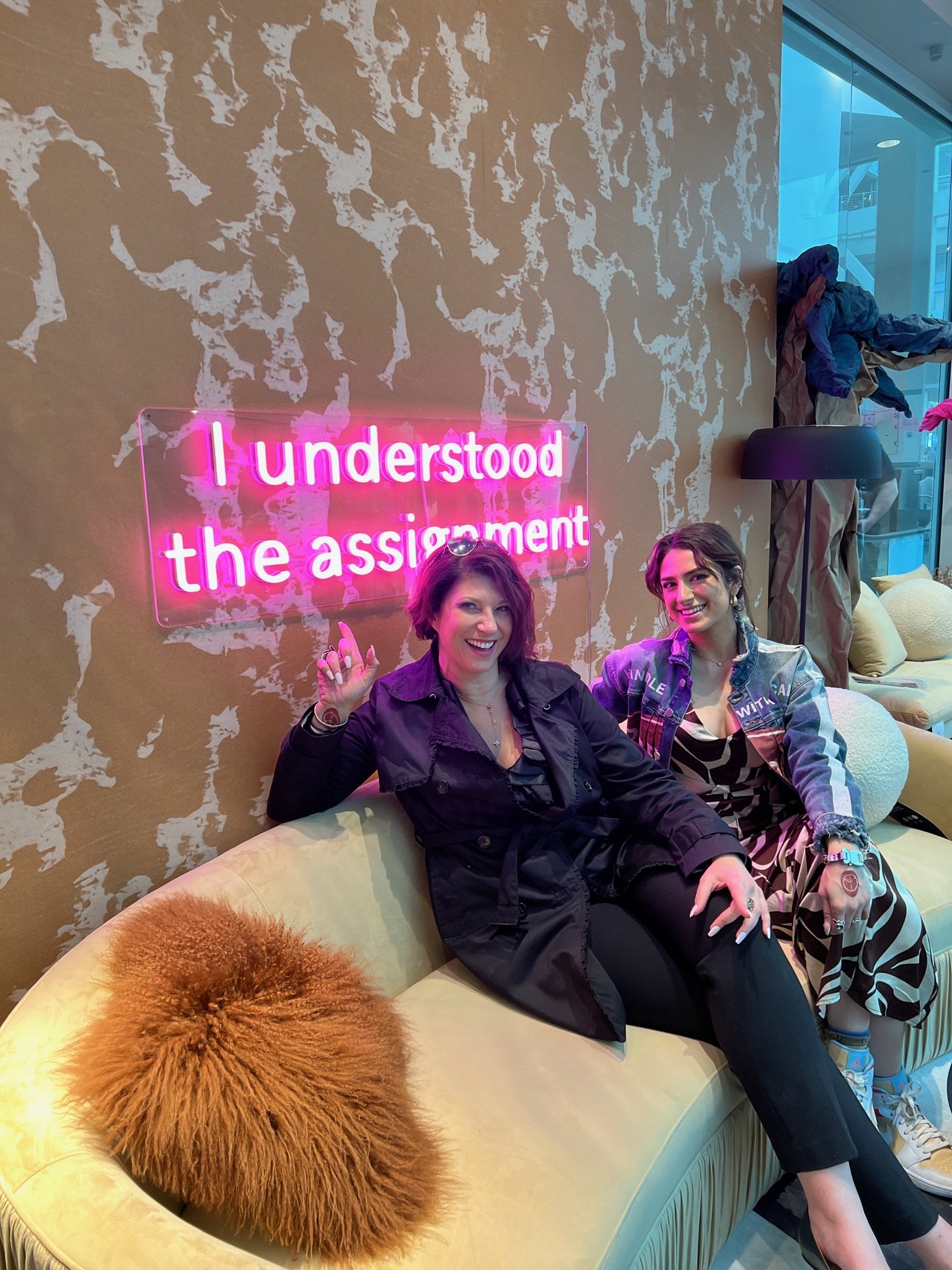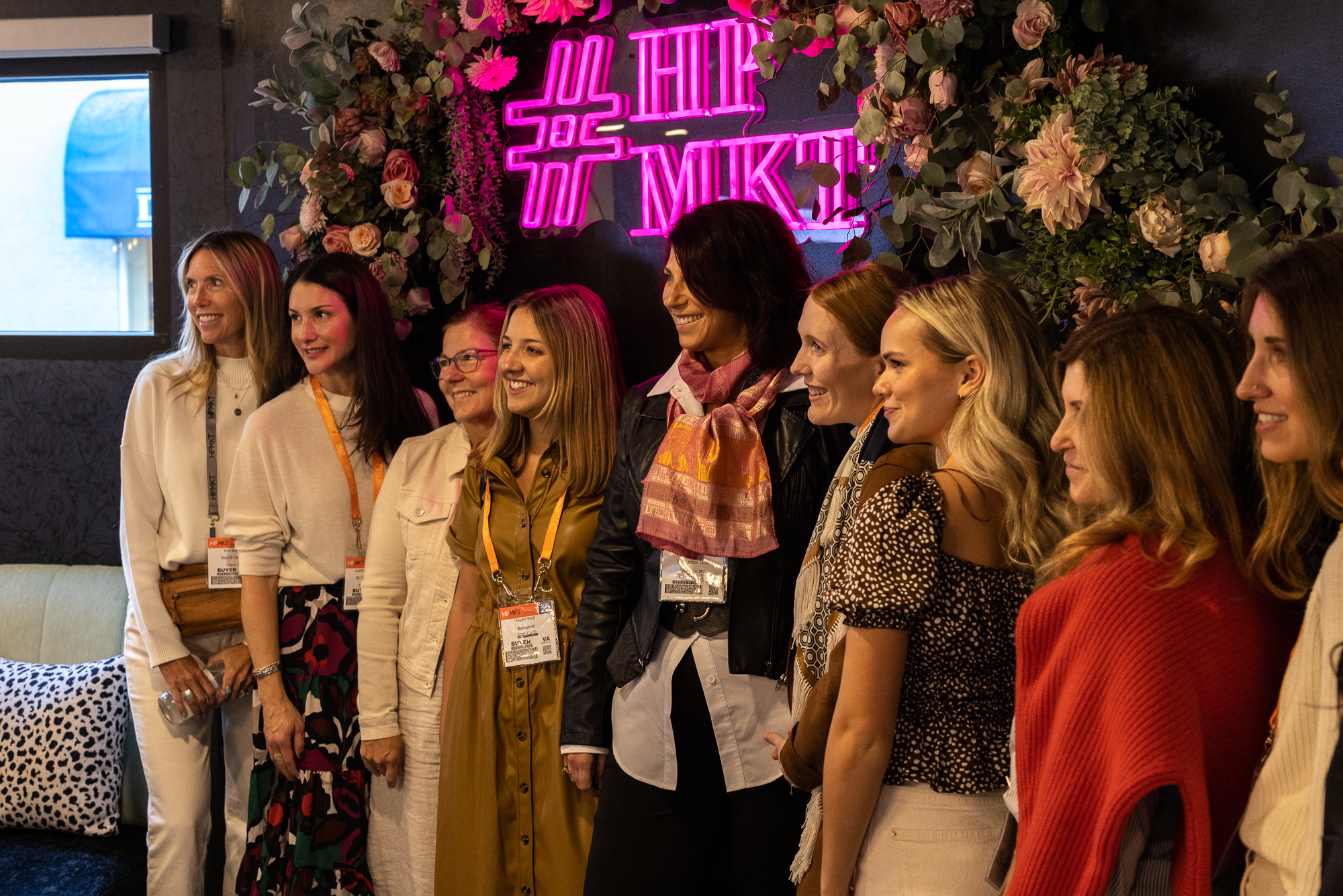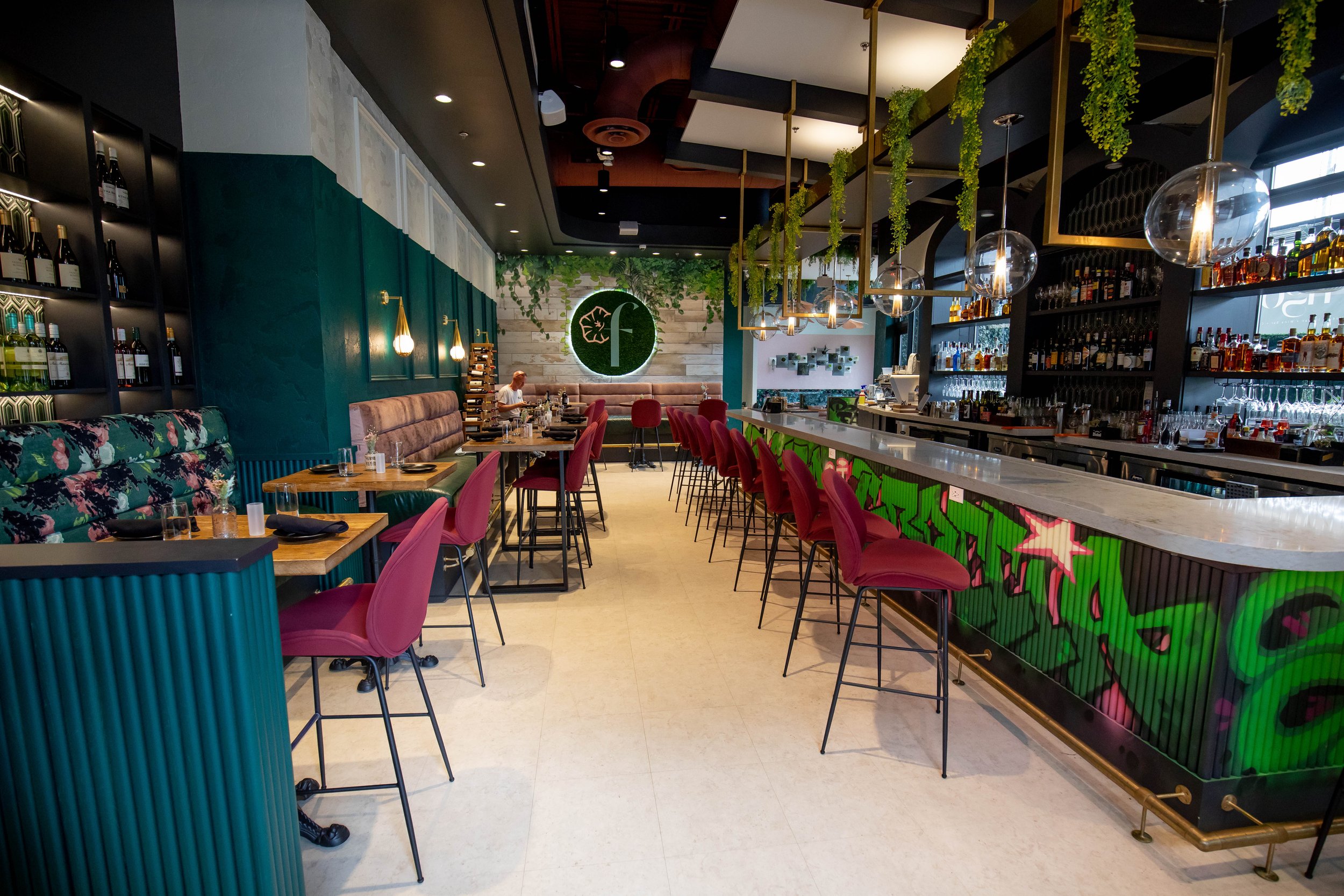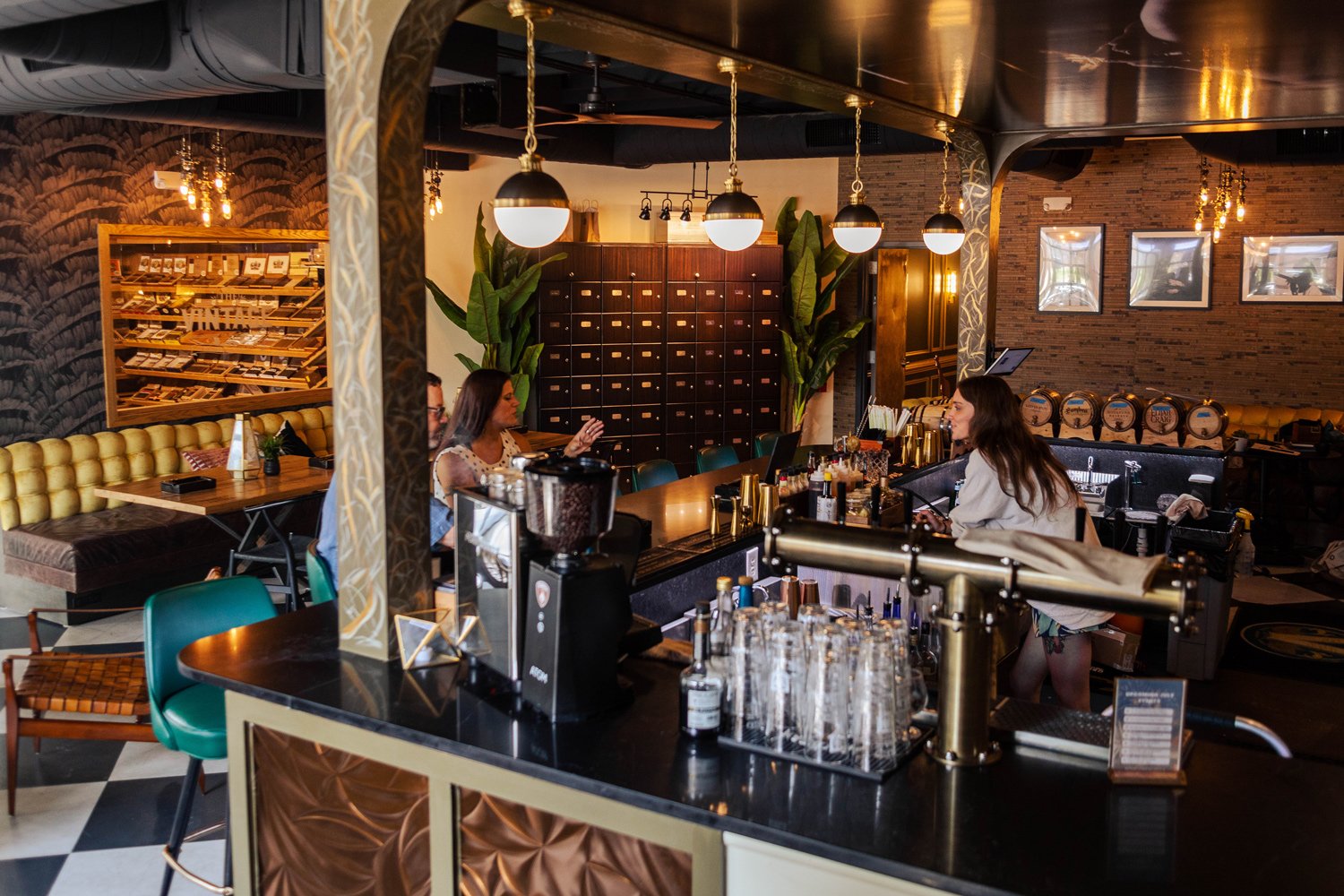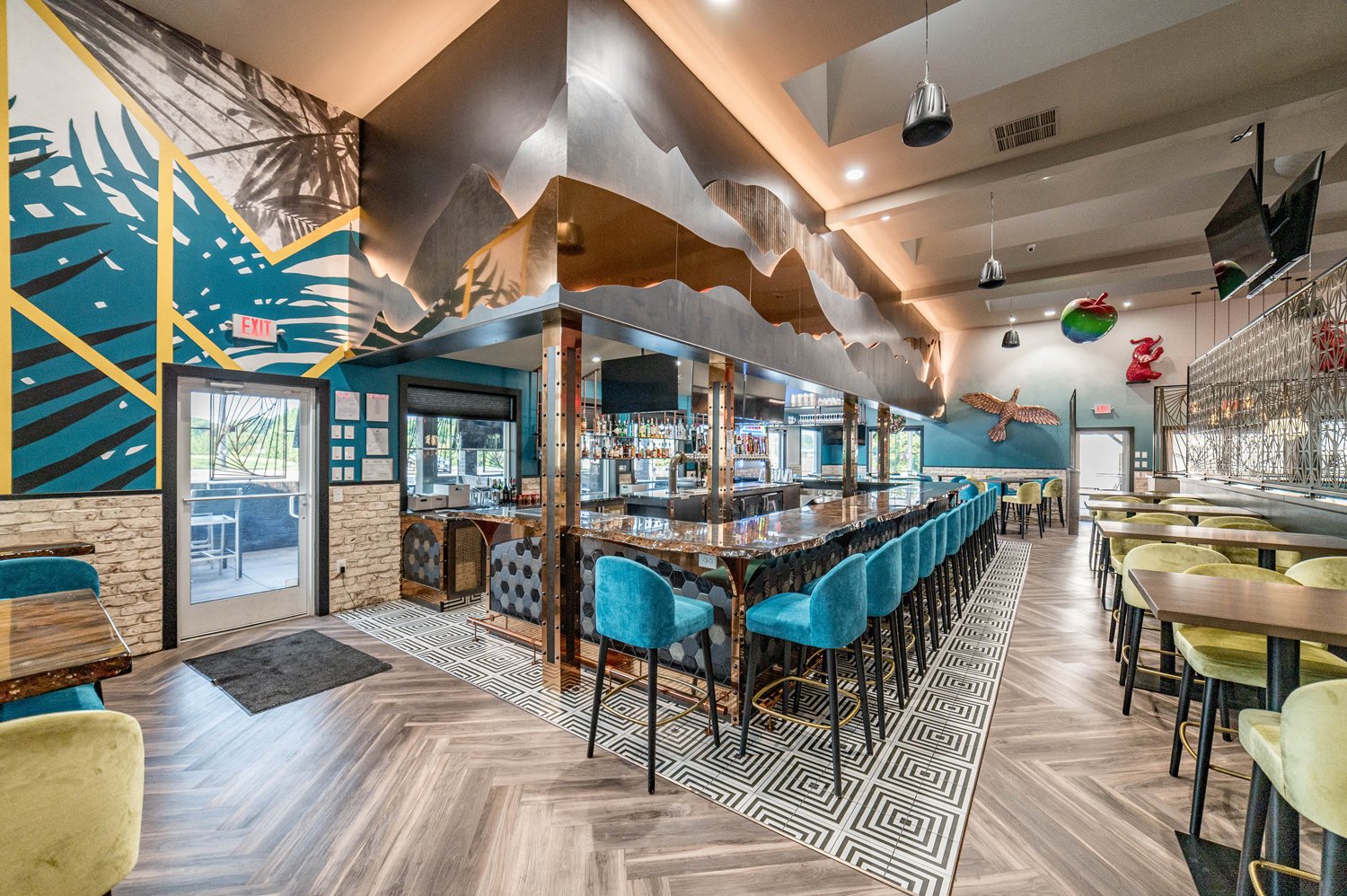Future-Proofing Commercial Spaces for 2030 and Beyond
By 2030, the brands that win won’t be the ones playing safe. They’ll be the ones building spaces that behave like living organisms, not static boxes. Reactive. Adaptive. And yes, occasionally a little mind-blowing.
What’s Next, What’s Permanent, and What We’re Done Pretending Isn’t Inevitable
Everyone loves to talk about “future-proofing.” Most of the time it’s fluff, slapped onto design decks like parsley on a plate. Cute, harmless, forgettable.
But real future-proofing, the kind that actually holds up past next year's trend cycle, takes guts. It demands questioning the industry’s sacred cows. It means telling a client “this won’t age well” even when the current Pinterest boards disagree. It means designing spaces that don’t cling to the past but unapologetically sprint toward what users will want, even if they don’t know it yet.
By 2030, the brands that win won’t be the ones playing safe. They’ll be the ones building spaces that behave like living organisms, not static boxes. Reactive. Adaptive. And yes, occasionally a little mind blowing.
Let’s get into it.
Designbar Adaptive Multi-Use Commercial Space
Flexibility Isn’t a Trend. It’s the Bare Minimum.
If a space does one thing anymore, it’s already outdated. Single-purpose design is the rotary phone of interiors. We’re over it.
According to S3T Koncepts, flexibility is now the top client demand — and honestly, they’re right. Hybrid work, evolving user habits, rising expectations in hospitality and multifamily… these forces have permanently changed the game.
The reality is this:
A space that can’t pivot fast becomes a liability.
We’re seeing:
Restaurants that morph into daytime coworking
Hotel lobbies functioning as social clubs, work hubs, lounges, and “I just need five minutes alone” zones
Retail turning into media studios at the drop of a hat
Multifamily amenities that flow from fitness to wellness to focus rooms to hangout lounges without breaking the aesthetic
If your room needs a construction crew every time the world shifts, it’s not future-proof — it’s a fossil.
Designbar Experiential Smart-Tech Lobby
Smart Tech Isn’t a Gadget. It’s the Skeleton of the Space.
The AEC Associates highlights IoT as the backbone of next-gen hospitality, and honestly, they're still underselling it. Smart tech isn’t a feature anymore. It’s the infrastructure.
Here’s the truth the industry is slow to admit:
Spaces without integrated tech will feel as outdated as a mall fountain.
The 2030 tech essentials:
Circadian lighting that supports biological rhythms
Multi-sensor systems controlling temp, acoustics, and lighting based on behavior
AI-driven environmental modeling
Smart glass creating privacy or views instantly
Seamless digital interfaces across hospitality, retail, and multifamily
AR storytelling that makes themed rooms obsolete
Immersive brand experiences that merge digital and physical
And now the part that separates the future-focused from the fossilized — the idea the old guard doesn’t want to talk about.
Designbar Futuristic Boutique Hotel Room
Let’s Talk About Immersive Guest Rooms, Because the Industry Is Tiptoeing Around This
Traditional hotel rooms are about to feel like museum exhibits. Pretty, sure. Functional, yes. But not enough.
The guest room of 2030 is a digital canvas.
Imagine walking into a room that doesn’t just look good but transforms. At the tap of a button, you choose the world you want to exist in for the night.
Scenario 1: Immersed in Nature
A projection-dome wrap fills the room with long golden grass blowing in the breeze. The HVAC system mimics natural wind patterns. The daylight temperature adjusts to “sun just starting to dip.” A fresh-cut-grass scent diffuses subtly into oxygen-enhanced air.
Scenario 2: Ocean Escape
You’re surrounded by rolling blue waves, soft surf sounds, and a color palette that shifts like water. The floor temperature drops slightly, mimicking cool sand. Light flickers like reflections off water.
Scenario 3: Live from Broadway
Live-streaming immersive theater projected around you with directional acoustics. No crowds. No lines. Champagne optional.
Scenario 4: Vegas Energy Without Leaving the Bed
Surround-sound club track, dynamic lighting, and crowd simulations for the guest who wants nightlife without shoes.
This isn’t sci-fi.
It’s possible with tech already in play.
And here’s the bold truth:
Hotels that don’t adopt this level of experiential transformation will lose the next generation of travelers.
Sustainability Is Past Due for an Upgrade
Let’s be blunt.
A recycled carpet tile isn’t innovation anymore — it’s the entry fee.
According to Data Insights Market, sustainable design is the primary growth driver for commercial interiors through 2033, and the clients demanding it aren’t tree-huggers. They’re business strategists.
Clients now expect:
Carbon-neutral materials
Recycled and repurposed finishes
Low-VOC everything
Smart mechanical systems reducing operational costs
Durable materials that age with grace, not shame
Sustainability isn’t branding. It’s survival.
Wellness Interior Design: No Longer Optional
JLL reports that wellness integration is surging in importance across commercial sectors. Good — because humans are finally noticing that environments affect their mental and physical state.
This wave brings:
Biophilia that does more than stage a photo
Daylight strategy as a science, not a hope
Intelligent air filtration
Color psychology applied with intention
If your space can’t make people feel better, someone else’s will.
Hybrid Amenity Models Are the New Standard
Fitness, coworking, social energy, quiet recharge, micro-wellness moments. One environment. Multiple moods. Seamless transitions.
Multifamily leads the charge. Hotels and workspace brands are scrambling to catch up.
Experiential Design Is Where Brands Will Live or Die
You can have the most functional space in the world. If it doesn’t make people feel something, it won’t stick.
Experiential design isn’t a buzzword. It’s the strategy that leads to viral moments, returning guests, and devoted users.
Your space isn’t competing with other spaces.
It’s competing with every memorable experience a person has ever had.
How to Future-Proof Without Guessing Wrong
1. Design for Adaptability
Layouts that shift. Furniture that reconfigures. Zones that serve multiple functions without killing the vibe.
2. Integrate Tech Quietly
No noisy interfaces. No clunky controls. No “where’s the switch” panic. Tech should feel like magic.
3. Lead with Sustainability and Wellness
It’s cheaper long term, smarter long term, and frankly, expected.
Why Future-Proofing Is a Profit Strategy, Not a Philosophy
Adaptable spaces reduce renovation cost.
Immersive, experiential environments create loyalty and buzz.
Wellness improves guest satisfaction.
Sustainability builds brand trust.
Future-proof design isn’t crystal-ball thinking.
It’s business acumen.
The Secret Ingredient of Brand Loyalty?
Discover how experiential, sustainable, and wellness-driven hospitality design transforms hotels and restaurants into unforgettable brand experiences. Learn how storytelling, sensory details, and sustainability turn guests into loyal fans.
Experiential Hospitality Design That Feels Personal
In hospitality design, it’s no longer enough to look good; your spaces need to FEEL good, SMELL good, and MEAN something. Today’s travelers are loyal not to logos, but to experiences. The most magnetic hotels and restaurants win hearts (and hashtags) through experiential design, spaces that blend story, sensory engagement, and emotional connection.
Welcome to the era where Hospitality Design meets storytelling and social shareability.
A lobby designed for connection: where atmosphere meets brand experience.
Design as the Heart of Brand Loyalty
Brand loyalty used to live in marketing. Now, it’s built into the architecture.
Whether it’s a boutique hotel, a destination restaurant, or a social club, guests crave authenticity. Every material, color palette, and lighting cue contributes to how they remember you, and whether they’ll come back.
Great Experiential Design creates emotional bonds. It transforms physical spaces into living expressions of brand identity, encouraging guests to share their experiences and, more importantly, return for more.
When done right, design IS your marketing.
Storytelling: The Soul of Experiential Design
Behind every memorable hotel or restaurant interior lies a story. Storytelling gives design its emotional depth; it’s how guests connect to your brand beyond the surface.
Rosewood Hotels’ “Sense of Place” mantra makes every property distinct, weaving local architecture, art, and materials into one narrative.
Ace Hotels turned lobbies into creative hubs where design and community intersect; the story isn’t just décor, it’s belonging.
STK, designed by ICRAVE, merges dining with nightlife, crafting a brand that’s as much about energy as cuisine.
At DESIGNBAR, storytelling drives every project. It’s Commercial Interior Design that performs double duty: functional and unforgettable.
Every texture has a purpose: a tactile narrative that connects guests to the brand.
Designing for Social Media Moments (Without Selling Out)
Let’s be honest, social media drives visibility. But the key isn’t chasing “Video-grammable” gimmicks; it’s crafting authentic, sensory moments worth capturing.
Think of it as sensory-focused interior design for hotels, spaces that photograph beautifully because they feel incredible in person.
Lighting that flatters, textures that invite touch, and vignettes that naturally frame people in the scene, these are the design details that turn guests into your best storytellers.
Remember: guests don’t share perfection; they share emotion. Design for surprise, delight, and connection, not just aesthetics.
Sustainability and Wellness: Loyalty’s Silent Influencers
Sustainability and wellness are no longer bonus features; they’re loyalty builders. Guests are increasingly loyal to brands that align with their values and make them feel good inside and out.
A sustainable hospitality design approach might include renewable materials, locally sourced finishes, low-VOC paints, or biophilic features that connect guests to nature. Even subtle choices, like circadian lighting or air-purifying plants, can increase satisfaction and perceived comfort by up to 30% (Cornell Hospitality Research, 2024).
When Sustainable Design meets Wellness Interior Design, guests don’t just love your brand, they trust it.
Sustainability meets serenity: wellness-focused hospitality design that nurtures loyalty.
Case Studies: When Design Becomes Brand
Dishoom, London
Every detail is rooted in nostalgia for 1960s Bombay cafés. The storytelling is so immersive that guests don’t just eat, they time travel.
Their private club aesthetic has become a design empire. Naturally so since SOHO House also focuses their exclusivity on Creatives. Loyalty here isn’t transactional, it’s emotional. Each property carries the same DNA but adapts to its locale.
Perhaps the best example of Sustainable Hospitality Design done right. From reclaimed wood to living walls, the design itself communicates their mission: “Luxury that’s light on the planet.”
From Blueprint to Brand Equity
Turning a design concept into brand loyalty starts with a few essential steps.
First, clarify the emotion your brand wants to evoke. Is it curiosity, calm, connection, or excitement. Then translate that feeling into spatial cues: textures, lighting, and flow that support that emotional journey. Layer in sensory experiences: sound, scent, touch, reinforce it.
Integrate Sustainable Design and Wellness Interior Design principles early, so the space feels both ethical and uplifting. And finally, observe how guests interact: where they linger, what they photograph, and how they describe their experience afterward.
That feedback is your brand blueprint evolving in real time.
Why This Matters
Design is now the most powerful brand medium. When your Hospitality Design strategy integrates Experiential Design, Sustainable Design, and Wellness Interior Design, guests don’t just visit, they belong.
They become advocates, storytellers, and loyal returnees. That’s the real ROI of design that feels personal, sensory, and human.
How to Make Old Spaces New Again:
Investors and developers want two things right now: resilient returns and places people want to be. Adaptive reuse—transforming underutilized or historic buildings into vibrant destinations—delivers both. At DESIGNBAR, we see adaptive reuse as more than a cost play; it’s a strategic way to honor the past while designing for today’s hospitality, wellness, and experience-driven expectations.
Adaptive Reuse in Design
Investors and developers want two things right now: resilient returns and places people want to be. Adaptive reuse—transforming underutilized or historic buildings into vibrant destinations—delivers both. At DESIGNBAR, we see adaptive reuse as more than a cost play; it’s a strategic way to honor the past while designing for today’s hospitality, wellness, and experience-driven expectations.
Why Adaptive Reuse Makes Business Sense
Adaptive reuse can compress timelines and reduce upfront costs compared to ground-up development—and it often outperforms “me too” new builds because character is a moat. CBRE’s 2022 analysis notes that repositioned assets frequently outperform peers thanks to unique identity and lower embodied carbon. Reusing structures also aligns with ESG goals by minimizing waste and reducing embodied emissions—an increasingly material factor for capital partners.
Warehouse to Boutique Hotel
Constraints That Spark Creativity
Yes, there are hurdles—aging systems, zoning, preservation guidelines. But those constraints are design fuel.
Hospitality conversions: A warehouse becomes a boutique hotel where sensory design (lighting, texture, acoustics) builds a signature guest experience.
Office-to-residential: Obsolete towers transform into high-demand multifamily with wellness-forward amenities that today’s renters actually use.
Mixed-use moments: Public spaces get reprogrammed for flexible work, curated retail, and community activation—all within an existing shell.
Office to Residential
Our Approach: Memory + Modernity
We design at the intersection of heritage and high performance. That means protecting the details that give a building its soul—and pairing them with systems, flows, and finishes that work hard for today’s users. Wellness isn’t an afterthought; it’s coded into the plan (air quality, acoustic comfort, circadian or 3000K dimmable lighting strategies, durable low-VOC materials). Experiential touchpoints—an arrival sequence, a sculptural moment, a sightline to daylight—turn space into story and story into brand equity.
What Developers & Investors Gain
Differentiation that leases: Character-rich product stands out, supports premium positioning, and sustains demand.
Faster activation: Selective demo + smart reprogramming often beat ground-up timelines.
ESG alignment: Lower embodied carbon and adaptive strategies resonate with institutional capital and municipal partners.
Enduring brand value: Spaces people remember are spaces people return to—and recommend.
Mixed-Use Spaces
Bottom line: Adaptive reuse isn’t “preservation for preservation’s sake.” It’s reinvention—where history meets opportunity and design compounds value.
Sources:
CBRE Research, “Adaptive Reuse: Repositioning Real Estate for Growth,” 2022
Urban Land Institute, “The Case for Adaptive Reuse,” 2021
Sensory Design in Commercial Interiors:
Design isn’t just visual—it’s sensory. The most memorable spaces don’t just look stunning; they feel immersive. From lighting and textures to sound and scent, sensory design engages people on multiple levels, creating emotional and behavioral responses that translate into loyalty, dwell time, and higher spending.
How Lighting, Textures & Sound Elevate the Guest Experience
Design isn’t just visual—it’s sensory. The most memorable spaces don’t just look stunning; they feel immersive. From lighting and textures to sound and scent, sensory design engages people on multiple levels, creating emotional and behavioral responses that translate into loyalty, dwell time, and higher spending.
Why Sensory Design Matters
Hospitality and retail environments rely on more than décor—they deliver experiences. According to research, dining venues rated neutral or unfavorable acoustics as the top source of dissatisfaction—even above price or crowding (studies show up to 24% report noise as most disruptive). Meanwhile, visual elements such as color and lighting shape initial impressions, but when combined with tactile and olfactory cues, they form powerful memory anchors.
Engaging multiple senses can boost emotional connection and perceived value. Experts note that design activating sight, touch, smell, and sound performs better at driving guest satisfaction and social sharing.
Lighting & Ambiance
Key Sensory Dimensions & Design Strategies
Lighting & Visual Ambience
Lighting isn’t decoration—it directs perception. Color temperature influences perceived warmth, spatial size, and mood. Research shows cool lighting can make spaces feel more alert, while warmer tones support relaxation and dining experiences. Layered lighting—ambient, accent, task—adds depth and flexibility.
Textures & Touch
Materiality matters. Soft textiles, tactile surfaces, and textural contrasts—from velvet to stone—create visual richness and invite engagement. Spaces with thoughtfully selected textures evoke comfort, luxury, and emotion, strengthening the guest connection.
Sound & Acoustic Quality
Soundscapes impact satisfaction and behavior. A study across 12 restaurants found that sound pressure level and reverberation time directly influence perceived soundscape pleasantness—and that pleasantness strongly predicts overall satisfaction. Excessive noise was cited as a top annoyance (24% of diners), causing shorter visits and fewer return visits. Music tempo and background sound also affect spending: upbeat dials revenue, relaxing tones increase dwell time.
Scent & Olfactory Cues
Olfactory elements hold surprising power. Thoughtful use of scent—like botanical aromas, fresh citrus, or signature fragrances—can evoke memory, mood, and brand identity. In hospitality and retail, scenting is often linked to higher dwell time and recall; it’s an underutilized but vital touchpoint.
Textural Materiality & Sensory Engagement
Designing a Servicescape That Works
The concept of the servicescape—the total built environment of a service setting—offers a framework for integrating sensory design intentionally. These elements include ambient conditions (lighting, temperature, sound), spatial layout, and style cues that evoke desired responses. The goal: design spaces that feel cohesive, welcoming, and memorable.
Practical Sensory Design Tips:
Use circadian lighting—or max 3000k lighting that is dimmable to manually imitate the circadian lighting rhythm—to align with guest rhythms and shift ambiance throughout the day.
Balance acoustics with sound-absorbing materials, zoned music, and proactive guest service for noisy situations.
Layer textures—like wood, brass, velvet, stone—to engage both sight and touch.
Scent strategically—coffee aromas in cafes, herbaceous notes in restaurants, tranquil lavender in wellness areas.
Why It Matters for your Business
When sensory design is done right, the results are measurable:
Improved guest satisfaction and dwell time
Increased spend per visit
Stronger brand recall/connection and more social media engagement
High-performing hospitality environments harness sensory cues to create emotional resonance, turning visitors into repeat customers and advocates.
We design emotional, intentional spaces that engage sight, sound, touch, and scent to elevate experience and loyalty.
Acoustic & Sense Responsive Wellness Space
Sources
Acoustical field study on restaurant sound and satisfaction (https://d-nb.info/1217416005/34, https://www.researchgate.net/publication/337146674)
Spatial multisensory design research (https://www.mdpi.com/2075-5309/15/8/1393, https://en.wikipedia.org/wiki/Sensory_design)
Sensory marketing and hospitality guide (https://medium.com/@faria.faria9/the-impact-of-sensory-design-on-user-engagement-and-satisfaction-fdf203409701, https://www.numberanalytics.com/blog/ultimate-guide-sensory-design-hospitality)
Servicescape environmental psychology model (https://en.wikipedia.org/wiki/Servicescape)
Beyond Decor: How Art Creates Identity in Commercial Interior Design
When art and interior design collide, something magical happens: brands come to life.
When art and interior design collide, something magical happens: brands come to life. In commercial spaces, curated artwork isn’t just wall candy—it can set the tone for how guests feel, engage, and remember your brand. From sculptural installations and statement murals to custom commissions that mirror a brand’s values, art has the power to elevate an environment from beautiful to unforgettable.
1. The Brand Power of Art in Design
Art can do what signage and furniture can't. It stirs emotion, tells a story, and creates instant recognition. In hospitality, retail, and workplace environments, art plays a crucial role in reinforcing brand values, setting emotional tone, and creating shareable moments. According to a 2018 Ipsos study, environments with emotionally resonant design and artwork increase perceived brand value and loyalty.
Take boutique hotels and experiential restaurants: A single sculptural centerpiece or interactive art wall can become a landmark that guests post about, remember, and associate with the entire experience. For brands, it’s an immersive, identity-driven tool that works on a subconscious level.
2. Choosing the Right Artists & Installations
Art selection is strategic, not just aesthetic. When sourcing art for a space, DESIGNBAR looks for:
Alignment with brand story: What do you stand for, and how can that show up in visuals?
Narrative cohesion: Art should extend the interior's storyline, not compete with it.
Material and scale: Large-format pieces in spacious lobbies, tactile 3D work in close-quarter lounges.
Engagement factor: Does it inspire curiosity, conversation, or social media interaction?
Working with local artists, cultural storytellers, or muralists can add authenticity and connect your brand to a place. In commercial settings, we also think about maintenance, safety, and longevity—an installation should be as durable as it is bold.
3. From Concept to Canvas: Real-World Examples
At DESIGNBAR, we infuse curated art into many of our projects to boost impact. Let's talk about a few standout moments:
Eight Sushi & Asian Kitchen: To match the restaurant’s edgy, high-energy atmosphere, we collaborated with local artists to commission mixed media pieces and a striking bar-front mural. This artwork visually interprets the symbolism behind the number eight, delivering both story and attitude. The result? A bold, expressive space where the art doesn’t just decorate—it drives the vibe.
Mellow Mushroom (Lynchburg, VA): A custom mural—woven directly into the interior concept—amplifies the rockstar personality of the franchisee while echoing the space’s eclectic, Art Deco-inspired design. This vibrant centerpiece instantly grabs attention and has become one of the most photographed moments in the restaurant.
FIGO36 (now Mabi): In a space where greenery and biophilic elements set a serene tone, we introduced visual tension with graffiti-style art and gritty industrial textures. Collaborating with a local artist, we contrasted floral patterns and muted rose hues with edgy Italian street art across the bar, host stand, and banquettes—creating a layered, dynamic atmosphere that’s anything but expected.
Final Thoughts: Make it Meaningful
In commercial interiors, art isn't a finishing touch—it's a strategic brand layer. Whether it’s immersive, interactive, or quietly powerful, the right piece becomes part of the guest experience. And when you treat art as design (not decor), it leaves a lasting impression.
Want to make your space more iconic? Let’s create a visual story that speaks louder than words.
Sources
Ipsos Design & Brand Identity Study: https://www.ipsos.com/en/brand-expression-design
Journal of Business Research: Art in the Workplace & Customer Loyalty: https://www.sciencedirect.com/science/article/pii/S0148296317300366
Architectural Digest: The Role of Art in Hospitality Design: https://www.architecturaldigest.com/story/hospitality-design-art
Your Square Footage Isn’t the Problem—Your Design Is.
In a world where flexibility is king, spaces that can multitask are no longer a luxury—they're a necessity. From hybrid hospitality concepts and coworking lounges to office lobbies that moonlight as event venues, multifunctional design has become a key player in how we maximize space, utility, and value.
In a world where flexibility is king, spaces that can multitask are no longer a luxury—they're a necessity. From hybrid hospitality concepts and coworking lounges to office lobbies that moonlight as event venues, multifunctional design has become a key player in how we maximize space, utility, and value.
We’re seeing a shift from static layouts to dynamic environments that adapt to how people actually use space. And when done right, multifunctional design doesn’t just save square footage—it elevates the experience.
Hybrid Hotel Lobby Workspace + Social Hub
1. Think Function First, Then Layer Aesthetics
Designing for flexibility starts with understanding how the space will be used—and by whom. Once that’s clear, the aesthetic story can follow.
What to Prioritize:
User Needs: Will the space serve individuals, groups, or both? Will it host events, meetings, or wellness sessions?
Flow: Clear pathways, intuitive zoning, and movable barriers prevent the space from feeling cluttered.
Infrastructure: Power access, lighting, acoustics, and tech need to be universal, not fixed to one use-case.
According to Steelcase's 2024 Workplace Futures Report, companies with adaptable office spaces reported a 23% increase in employee satisfaction and space utilization.
High-Performance Modular Lounge Space
2. The Power of Modular Everything
Modularity is the backbone of multifunctional design. It allows spaces to transform quickly, often without needing renovation or reconfiguration.
Key Features:
Reconfigurable Furniture: Seating that nests, stacks, or converts from lounge to task.
Flexible Lighting Systems: Track lighting, dimmables, and mobile fixtures support multiple vibes in one space.
Mobile Dividers: Soft partitions, acoustic curtains, or plant walls offer temporary zoning without permanent walls.
Spaces designed with modular systems have been shown to reduce operational costs by up to 18%, according to CBRE (2023 Commercial Design Forecast).
Transformative Amenity Space in Residential Building
3. Style That Serves
A multifunctional space doesn’t need to feel utilitarian. Design choices should support versatility without sacrificing brand identity or atmosphere.
What Works:
Neutral Base Palettes: Let lighting, artwork, or moveable decor set the tone per event or use-case.
Durable Materials: Think performance fabrics, sealed natural stone, and acoustic-friendly finishes.
Tech That Blends In: Built-in speakers, hidden projection systems, plug-and-play tech, and easy access to charging connections keep the aesthetic clean and the functionality seamless.
Design Insight: Visual consistency across different configurations builds trust and usability—even when the space shape-shifts.
Coworking Café in Use — Day to Night Flex
4. Real-World Applications
Coworking Cafes: Lounge by day, event space by night, and networking hub in between.
Hotel Lobbies: Morning check-ins become afternoon coworking and evening cocktail hours.
Residential Amenities: Fitness rooms that double as yoga studios or community rooms that host everything from meetings to movie nights.
These types of spaces cater to the way people actually live and work today—blurring lines between functions to create more value for every square foot.
Why It Matters
Multifunctional design is about meeting people where they are—and giving your space the flexibility to keep up. It’s efficient, it’s smart, and when executed well, it’s downright beautiful.
We design spaces that flex with purpose and flow with style. Ready to get more from your square footage? Let’s talk.
Sources:
Steelcase Workplace Futures Report, 2024 (Steelcase)
CBRE Commercial Design Forecast, 2023 (CBRE)
Your Office Might Be Killing Productivity (Here’s How to Fix It)
The workplace isn’t dead—it’s just evolving. As companies navigate the balance between remote work, hybrid schedules, and in-person collaboration, the office is being reimagined not as a place where people have to go, but one they want to go to.
The workplace isn’t dead—it’s just evolving. As companies navigate the balance between remote work, hybrid schedules, and in-person collaboration, the office is being reimagined not as a place where people have to go, but one they want to go to.
We design workspaces that empower productivity, foster flexibility, and prioritize employee wellness. Why? Because a well-designed office isn’t just a perk—it’s a performance strategy. Let’s break down what the future of workplace design looks like and how to design for what’s next.
Zoned Work Environment - Productivity is Personal
1. Productivity Is Personal
Gone are the days of one-size-fits-all cubicles and sterile boardrooms. Today’s workspaces must support different work styles, tasks, and energy levels.
What Works:
Zoned Environments: Quiet zones for deep focus, casual lounges for creative thinking, and collaborative hubs for teamwork.
Task-Based Design: Spaces designed around the type of work being done rather than job titles or departments.
Tech Integration: High-speed connectivity, digital whiteboards, and hybrid meeting setups that work as well for remote attendees as they do in the room.
According to Gensler’s 2024 U.S. Workplace Survey, offices with task-based zones see a “17% increase in employee satisfaction and focus”.
Flexible Workspace with Modular Layout and Hot-Desking
2. Flexibility Is the New Rule
Static seating charts are out. Fluidity is in. The future workplace needs to adapt—quickly—to changing team dynamics and evolving business needs.
How to Design for Flexibility:
Modular Furniture: Moveable tables, reconfigurable seating, and portable whiteboards allow for on-the-fly transformation.
Multi-Use Spaces: Meeting rooms that double as event spaces or meditation rooms during off-hours.
Hot-Desking Done Right: When paired with lockers, personalized lighting, and acoustic control, hot-desking can actually boost collaboration.
Deloitte’s 2023 Future of Work report found that “62% of organizations investing in flexible workplace infrastructure reported improved team innovation”.
Wellness Centered Workplace
3. Wellness as a Non-Negotiable
The link between employee well-being and productivity is crystal clear. The best workplaces support physical, mental, and emotional health through intentional design.
Wellness-Forward Features:
Biophilic Elements: Natural light, greenery, and organic textures that reduce stress and enhance focus.
Air & Sound Quality: Acoustic zoning, sound masking, and air purification systems.
Recharge Rooms: Quiet spaces for mindfulness, rest, or just stepping away from the noise.
WELL-certified buildings have been shown to contribute to a “25% drop in reported sick days and 26% improvement in cognitive function”, according to the International WELL Building Institute.
4. Purpose-Driven Aesthetics
Your office is your brand’s physical handshake. The visual language of your workspace should reflect your culture, values, and ambitions.
Designing for Culture:
Use color psychology to energize or calm, depending on the zone.
Incorporate local art or custom branding moments.
Embrace inclusive, accessible design to ensure every employee feels seen.
Why It Matters
Workplace design isn’t just about desks and meeting rooms. It’s about building a culture of performance, creativity, and well-being. Companies that prioritize intentional design are seeing better retention, stronger engagement, and bigger results.
We specialize in creating work environments that work for people, not against them. Ready to future-proof your office? Let’s talk.
Sources:
Gensler U.S. Workplace Survey, 2024 (Gensler)
Deloitte Future of Work Report, 2023 (Deloitte)
International WELL Building Institute, 2024 (IWBI)
The Role of Experiential Design in Restaurant Success
Let’s be honest—great food might get guests in the door once, but a memorable experience is what keeps them coming back.
Let’s be honest—great food might get guests in the door once, but a memorable experience is what keeps them coming back. In today’s hospitality scene, where diners are constantly chasing their next favorite spot, experiential design has emerged as a powerful driver of customer retention and restaurant success. It's not just about pretty spaces—it’s about creating an immersive environment that delights the senses, supports functionality, and brings the brand to life.
Immersive Restaurant Dining Room
At DESIGNBAR, we’ve seen firsthand how intentional design transforms how guests engage with a restaurant. From layout to lighting to the vibe that lingers long after the check is paid, every detail matters.
1. How Thoughtful Design Impacts Customer Retention
According to a 2024 report by Hospitality Insights, 78% of diners say ambiance plays a critical role in their decision to return to a restaurant, sometimes even outweighing food quality.
Why It Works:
The right atmosphere increases dwell time (hello, extra drink orders!).
Consistent design creates familiarity and brand recognition.
Thoughtful sensory cues (lighting, acoustics, scent) enhance emotional connection.
Smart design doesn’t just attract new customers—it builds loyalty.
2. Balancing Aesthetic Appeal with Functionality
Restaurant design is more than creating a pretty Instagrammable backdrop —it needs to work. From a service flow standpoint to the guest journey including the cameras they bring, functionality must be woven into every aesthetic choice.
Key Design Balancing Acts:
Flow Matters: Smart circulation helps guests move comfortably and ensures staff efficiency during peak hours.
Material Selection: Durable, easy-to-clean finishes can still look gorgeous. Think performance velvet, sealed concrete, and antimicrobial surfaces.
Zoning Spaces: Energetic bar zones vs. cozy dining nooks. Great design accommodates different guest moods and needs.
According to the National Restaurant Association, restaurants that invest in optimized layouts and zoning see a 12-15% increase in revenue due to improved table turnover and operational flow.
3. What Experiential Design Looks Like in Action
Circadian lighting that aligns with the body’s natural rhythms, acoustics that support conversation, touchable textures, and intentional branding moments—these are all pillars of experiential design. Circadian lighting helps guests feel more energized during daytime hours and more relaxed in the evening, subtly guiding their mood and engagement with the space.
Pro Design Tips:
Integrate technology like circadian lighting systems, adaptive acoustic controls, immersive projection technology, dynamic airflow features, and programmable scent profiles to transform the environment entirely. Together, they can influence how guests feel, energize the space, or create calm depending on the time of day or event.
Use layered materials to engage the senses.
Build flexibility into the space (modular furniture, movable dividers).
Holistic Dining Experience
Why It All Matters
Experiential design isn’t a luxury anymore—it’s a business strategy. It influences time spent in the space, emotional connection, and brand loyalty. Restaurants that lean into it are the ones seeing higher margins, stronger reviews, and more loyal guests.
At DESIGNBAR, we specialize in designing hospitality environments that aren’t just functional—they’re unforgettable. From visual storytelling to intuitive flow, we design spaces that stick.
Ready to serve up an experience your guests won’t forget? Let’s talk.
Sources:
Hospitality Insights, 2024 (HI)
National Restaurant Association, 2024 (NRA)
Wellness Design: Beyond Spa Spaces
Infusing Wellness Principles into Everyday Commercial Spaces
Wellness design isn't just for spas anymore. It’s popping up everywhere—from offices and hotels to restaurants and retail spaces. Why? Because wellness is no longer just a trend; it’s a lifestyle standard.
Infusing Wellness Principles into Everyday Commercial Spaces
Wellness design isn't just for spas anymore. It’s popping up everywhere—from offices and hotels to restaurants and retail spaces. Why? Because wellness is no longer just a trend; it’s a lifestyle standard.
At DESIGNBAR, we bring wellness design into everyday environments where people gather, work, and play. Our WELL-certified designers know how to integrate health and well-being principles into all kinds of commercial spaces.
Urban Restaurant Biophilic Design
1. Biophilic Design: Bringing the Outdoors In
People feel better when they’re connected to nature. According to the Global Wellness Institute, biophilic design can boost productivity by 15% and reduce stress by 30%.
Tips:
Maximize natural light and add greenery (living walls, potted plants).
Use natural materials like wood and stone for warmth and authenticity.
Enhance the experience with water features or nature sounds.
2. Wellness-Focused Interiors in High-Traffic Urban Spaces
Offices, restaurants, retail spaces, and urban environments are embracing wellness design to enhance user experience, brand loyalty, and comfort even in bustling settings. According to the Urban Land Institute, 87% of urban professionals prefer environments with wellness features.
What Works:
Offices: Ergonomic furniture, quiet zones, and air purification systems.
Restaurants: Thoughtful acoustics, greenery, and wellness-oriented menus.
Retail: Minimalist design, natural materials, and calming scents.
Urban Areas: Rooftop gardens, soundproofed lounges, wellness pods, and micro-moments of relaxation within high-energy locations.
4. Sustainability & Low VOC Materials
Wellness design isn’t just about relaxation—it’s about health. Using low VOC paints and eco-friendly materials promotes better air quality and reduces environmental impact.
What to Look For:
Low or zero VOC paints and finishes.
Bamboo, reclaimed wood, and other sustainable materials.
Certifications like GREENGUARD, LEED, or WELL Building Standard.
5. Making Wellness Design Work for You
Assess user needs—what does wellness mean to your audience?
Incorporate natural elements like light, plants, and organic textures.
Prioritize air quality, lighting, and comfort.
Keep it effortless—design should feel natural, not forced.
Multi-Family Rooftop Garden
Wellness design is about more than feeling good; it’s about creating spaces that enhance health, productivity, and happiness. At DESIGNBAR, we’re bringing these principles to all kinds of commercial spaces, thanks to our WELL-certified designers.
Ready to infuse wellness into your environment? Let’s talk.
Sources:
Global Wellness Institute, 2024 (GWI)
Urban Land Institute, 2024 (ULI)
Sensory Design
Great design isn’t just about what you see—it’s about what you feel. The best spaces don’t just look stunning; they engage all the senses, creating an atmosphere that resonates on a deeper level. Welcome to the world of sensory design, where lighting, textures, and sound work together to shape unforgettable experiences.
How Lighting, Textures, and Sound Elevate Spaces
Great design isn’t just about what you see—it’s about what you feel. The best spaces don’t just look stunning; they engage all the senses, creating an atmosphere that resonates on a deeper level. Welcome to the world of sensory design, where lighting, textures, and sound work together to shape unforgettable experiences.
Whether it’s a hotel lobby that instantly soothes, a restaurant that feels electric with energy, or a luxury apartment that fosters tranquility, sensory design is the key to creating immersive spaces that keep people coming back. At DESIGNBAR, we know that when you design for the senses, you design for impact.
Let’s break it down: how do lighting, textures, and sound influence a space, and how can they be leveraged to elevate the guest experience?
1. Lighting: Setting the Mood & Influencing Behavior
Lighting does more than illuminate a space—it shapes emotions. Studies show that proper lighting design can increase a guest’s dwell time by up to 20% and boost perceived value by 30% (Harvard Business Review, 2024).
How to Use Lighting Effectively:
Warm vs. Cool Tones: Warm lighting (think soft golden hues) creates intimacy and relaxation, perfect for hospitality spaces like boutique hotels and restaurants. Cool lighting, on the other hand, promotes alertness and focus—ideal for co-working lounges and offices.
Layered Lighting: Combine ambient, task, and accent lighting to create depth and highlight key design elements.
Dynamic & Adaptive Lighting: Circadian lighting systems mimic natural daylight patterns, enhancing wellness and productivity in workspaces and residences alike.
Statement Fixtures: Chandeliers, LED strips, and artistic pendants add personality and make spaces Instagram-worthy.
Smart Design Tip: Use dimmable lights to adjust ambiance throughout the day—brighter in the morning, softer in the evening.
Ambient Restaurant Lighting
2. Textures: The Power of Touch & Visual Depth
Texture is one of the most underrated design elements, yet it’s one of the most powerful ways to create a visually and physically engaging space. Research suggests that people associate soft, natural textures with comfort and luxury, increasing their emotional connection to a space by 40% (Psychology of Interior Design, 2023).
How to Incorporate Texture:
Layering Different Materials: A mix of matte and glossy finishes, rough and smooth surfaces, or hard and soft textiles adds richness and depth.
Natural Elements: Wood, stone, and woven fibers create warmth and authenticity.
Tactile Details: Plush seating, handwoven rugs, and textured wall treatments make a space feel dynamic and inviting.
Contrast for Impact: Velvet against metal, smooth marble next to raw wood—juxtaposition creates intrigue.
Smart Design Tip: Texture affects acoustics—soft materials absorb sound, while hard surfaces reflect it. Balance is key to both aesthetics and function.
Moody Boutique Hotel Lobby
3. Sound: The Silent Game-Changer
A space’s soundscape can be just as impactful as its visual appeal. Studies indicate that strategic sound design can improve guest satisfaction by 35% and increase spending in hospitality settings by 15% (Acoustical Society of America, 2024).
How to Design with Sound:
Ambient Noise Control: Soundproofing materials (acoustic panels, upholstered furniture) minimize disruptive noise in hospitality and co-working spaces.
Curated Soundscapes: A luxury spa benefits from soft instrumental music, while a high-energy restaurant thrives on upbeat, lively tunes.
Biophilic Sound Design: Incorporating natural sounds—like gentle water features or rustling leaves—enhances relaxation and focus.
Zoning Spaces Acoustically: Different areas require different audio experiences; design should reflect that (e.g., quiet nooks in co-working spaces, vibrant dining atmospheres).
Smart Design Tip: Think beyond music—consider how the absence of noise in certain areas creates a more premium experience.
Luxury Urban Apartment
Sensory Design in Action: Why It Works
When lighting, texture, and sound align, the results are transformative. Imagine:
A hotel lobby where soft, diffused lighting, natural stone walls, and gentle ambient music make guests instantly feel at ease.
A restaurant where dim, moody lighting, plush velvet booths, and an energetic curated playlist set the perfect dining experience.
A luxury apartment where warm lighting, layered textiles, and noise-reducing design create a serene urban retreat.
At DESIGNBAR, we specialize in crafting sensory-rich environments that turn spaces into experiences. Whether it’s designing a hospitality venue, a luxury residence, or a commercial space, we bring together lighting, textures, and sound to make sure every space doesn’t just look good—it feels good too.
Want to design a space that engages all the senses? Let’s talk.
Sources:
Harvard Business Review, 2024 (HBR)
Psychology of Interior Design, 2023 (PID Journal)
Acoustical Society of America, 2024 (ASA)
Amenities That Attract Long-Term Residents
Designing for Comfort, Community, and Convenience
Designing for Comfort, Community, and Convenience
In the world of multifamily living, amenities are no longer just "nice-to-haves"—they're deal-breakers. Long-term residents aren’t just looking for a place to live; they want a lifestyle, a community, and a space that supports their work, wellness, and social life. As more renters embrace the idea of settling in for the long haul, developers and property managers need to rethink their approach to amenities. What makes people stay? And, more importantly, what makes a space feel like home?
At DESIGNBAR, we know that thoughtful, experience-driven design is the key to turning a building into a vibrant, long-term living destination. Let’s break down the amenities that keep residents renewing their leases year after year—and how smart design makes all the difference.
1. Wellness & Fitness Spaces That Go Beyond the Basics
Gone are the days when a treadmill in a windowless room counted as a fitness center. Today’s residents expect wellness-focused spaces that integrate seamlessly into their daily routines. According to the 2024 NMHC/Kingsley Apartment Resident Preferences Report, over 55% of renters prioritize wellness amenities when choosing an apartment.
What Works:
Boutique-Style Fitness Centers: Think curated spaces with high-end gym equipment, on-demand workout classes, and personal training zones.
Yoga & Meditation Rooms: Quiet, beautifully designed areas for relaxation and mental well-being.
Outdoor Wellness Spaces: Walking trails, rooftop gardens, and community green spaces that encourage movement and mindfulness.
Cold Plunge & Recovery Lounges: The rise of biohacking and recovery spaces makes features like saunas, infrared therapy, and cold plunge pools highly attractive.
Smart Design Tip: Natural light, soundproofing, and air-purifying plants make these spaces feel more inviting and effective.
Luxury Multifamily Wellness Space
2. Work-From-Home Friendly Co-Living Spaces
With remote work still dominating, residents want more than just an extra bedroom to function as an office. In fact, over 40% of renters consider dedicated co-working spaces a must-have amenity (Multifamily Executive, 2024).
What Works:
High-Speed WiFi & Tech-Savvy Lounges: Seamless connectivity is non-negotiable.
Private & Semi-Private Work Pods: Residents want options for both quiet, focused work and casual collaboration.
Reservable Conference Rooms: Soundproof spaces for virtual meetings and in-person brainstorming sessions.
Coffee Bars & Snack Stations: A social component that fosters interaction while maintaining productivity.
Smart Design Tip: Acoustic treatments, ergonomic furniture, and biophilic elements enhance comfort and functionality.
High-Tech Co-Working
3. Social & Entertainment Hubs for Community Building
People stay where they feel connected. Community-focused amenities are just as critical as private living spaces, with 70% of renters saying they’re more likely to renew if they feel a sense of belonging (Apartment List, 2023).
What Works:
Clubhouses with Multi-Use Spaces: Think sleek lounges that double as event spaces, movie nights, and pop-up dining experiences.
Outdoor Fire Pits & Rooftop Bars: Designed for casual gatherings and networking.
Game & E-Sports Lounges: With the rise of gaming culture, modern apartment buildings are incorporating gaming setups, VR rooms, and e-sports lounges.
Chef’s Kitchens & Communal Dining Areas: Cooking classes, wine tastings, and supper clubs add major lifestyle value.
Smart Design Tip: Integrate flexible, modular furniture that allows spaces to transform based on residents’ needs.
Vibrant Community Rooftop
4. Pet-Friendly Perks That Make a Difference
Pet ownership is at an all-time high, with nearly 70% of renters owning pets (Forbes, 2024). Properties that don’t cater to four-legged family members risk losing out on a huge segment of long-term renters.
What Works:
Pet Spas & Grooming Stations: On-site facilities make pet care convenient.
Dog Parks & Agility Courses: Safe, engaging outdoor spaces keep pets and owners happy.
Pet Concierge Services: Walking, daycare, and vet partnership programs add extra convenience.
Smart Design Tip: Use durable, pet-friendly materials like scratch-resistant flooring and odor-neutralizing finishes to keep spaces fresh and stylish.
5. Sustainable & Smart Tech Integration
Sustainability is more than just a buzzword—it’s a necessity. Nearly 65% of renters are willing to pay more for eco-friendly features (National Apartment Association, 2024). Green initiatives not only attract environmentally conscious residents but also reduce operational costs over time.
What Works:
Energy-Efficient Appliances & Smart Thermostats: Lower utility bills while reducing carbon footprints.
Solar-Powered Common Areas: Offsetting energy costs with renewable energy sources.
Smart Lighting & Automated Climate Control: Enhancing comfort while cutting waste.
Electric Vehicle (EV) Charging Stations: A major incentive for long-term renters with electric cars.
Smart Design Tip: Sustainable design should be seamlessly integrated—think biophilic elements, recycled materials, and passive cooling techniques.
The Bottom Line: Design for Longevity, Not Just Lease Signings
The future of multifamily design isn’t just about building spaces—it’s about curating experiences that keep residents engaged and renewing their leases year after year.
At DESIGNBAR, we specialize in creating thoughtfully designed, experience-driven spaces that resonate with today’s long-term renters. Whether it’s incorporating wellness features, optimizing co-working hubs, or crafting vibrant community spaces, we know how to design for longevity.
Want to create a multifamily space that people don’t just live in but thrive in? Let’s talk.
Sources:
NMHC/Kingsley Apartment Resident Preferences Report, 2024 (NMHC)
Multifamily Executive, 2024 (Multifamily Executive)
Apartment List, 2023 (Apartment List)
Forbes, 2024 (Forbes)
National Apartment Association, 2024 (NAA)
How Technology is Re-shaping Guest Experiences in Hospitality
The hospitality industry has always been about creating memorable experiences, but let’s be real—the game has officially leveled up. Today, technology isn’t just in the background—it’s center stage, reshaping how hotels and restaurants create wow-worthy moments for their guests. From smart room features to immersive dining experiences, technology is no longer a nice-to-have; it’s a must-have. And in an era where content creators are capturing and sharing every moment, the visual aesthetics of tech-integrated spaces play a critical role in making these experiences not only functional but also Instagram-worthy. At DESIGNBAR, we believe that the magic happens when cutting-edge tech and intentional design come together to elevate guest satisfaction and boost business results.
Why Technology Matters in Hospitality
Let’s call it like it is: guest expectations are through the roof these days. Travelers and diners alike are looking for seamless, personalized, and immersive experiences. The right technology doesn’t just meet these expectations—it exceeds them. Here’s why it matters:
Convenience and Efficiency: Guests want control at their fingertips. Think mobile check-ins, keyless room access, and on-demand services.
Personalization: Smart systems can learn preferences, offering tailored recommendations for everything from room settings to dining options.
Immersion: Technology can turn a simple stay or meal into an unforgettable experience through interactive features, AR/VR, and more.
Sustainability: From energy-efficient systems to waste reduction, tech plays a critical role in creating eco-friendly hospitality environments.
Tech Trends Transforming Guest Experiences
Smart Rooms
Imagine entering a hotel room where the lights adjust to your preferred brightness, the thermostat is set to your favorite temperature, and your music playlist starts playing. Smart rooms are redefining comfort and convenience—and for content creators, these visually engaging, customizable spaces double as the perfect backdrop for capturing moments to share with their audiences.Immersive Dining
AR menus, interactive table projections, and virtual reality dining experiences are revolutionizing how we engage with food. It’s not just about taste; it’s about storytelling and sensory exploration. For content creators, these immersive experiences provide a wealth of visually compelling content, turning every meal into a shareable moment.Contactless Everything
From mobile check-ins to digital payment systems, contactless technology is here to stay. It’s not just convenient; it’s essential in a post-pandemic world.AI and Chatbots
AI-driven assistants are enhancing service delivery by answering questions, handling requests, and even predicting guest needs in real time.Sustainable Tech
Energy management systems, water-saving technologies, and AI-driven efficiency tools are helping hospitality businesses lower their carbon footprint while cutting costs.
The Business Case for Tech-Driven Guest Experiences
Investing in technology isn’t just about keeping up with trends; it’s about driving business success. Here’s how:
Higher Revenue: Enhanced guest experiences often translate into higher spending. For example, personalized recommendations can encourage guests to explore premium services. A case study of LuxStay Hotels demonstrated a 15% increase in revenue through upselling personalized services and promotions based on guest preferences and historical data (Digital Defynd).
Operational Efficiency: Automation reduces manual work, freeing up staff to focus on what really matters—delivering exceptional service. The 2024 Lodging Technology Study indicates that more than 4.2% of overall revenue was allocated to IT budgets in 2023, up from 4% a year ago, underscoring the industry's commitment to digital transformation for improved efficiency (Hospitality Tech).
Guest Loyalty: Memorable tech-driven experiences create lasting impressions, leading to repeat business and glowing reviews. AI integrations in loyalty programs have been shown to improve retention rates by 25%, highlighting the impact of technology on guest loyalty (SEO Sandwitch).
Brand Differentiation: In a crowded market, innovative technology sets you apart, attracting tech-savvy travelers and diners. Smart hotels with advanced room technology, IoT integration, and mobile device compatibility are gaining popularity among tech-savvy guests, making technology adoption crucial for maintaining competitiveness (Hotel Tech Report).
How Interior Design Brings Tech to Life
Here’s the scoop: technology only shines when paired with intentional, next-level design. At DESIGNBAR, we integrate tech into spaces seamlessly, ensuring it enhances rather than overwhelms the guest experience. Here’s how:
Hiding the Wires: Sleek integrations ensure technology blends into the design without compromising aesthetics.
Enhancing Flow: Smart layouts maximize the functionality of tech features, making them intuitive and user-friendly.
Creating Atmosphere: Lighting systems, soundscapes, and interactive displays work in harmony with the space’s overall vibe.
Steps to Get Started with Tech-Enhanced Design
Ready to embrace the future of hospitality? Here’s how to start:
Identify Guest Pain Points: What do your guests want, and how can technology solve those needs?
Collaborate with Experts: Work with design and tech professionals to create a seamless integration plan.
Start Small: Introduce one or two tech features, such as keyless entry or smart lighting, and build from there.
Focus on ROI: Prioritize technologies that offer measurable benefits, whether it’s energy savings, increased revenue, or improved guest satisfaction.
Conclusion
Technology is reshaping the hospitality landscape, creating new opportunities to delight guests and drive business success. When paired with intentional design, tech becomes more than a tool; it becomes a cornerstone of exceptional guest experiences. At DESIGNBAR, we’re passionate about bringing these innovations to life in a way that’s functional, stylish, and impactful.
Ready to turn your space into the tech-savvy, guest-pleasing marvel it was meant to be? Contact us today, and let’s make some magic happen.
The Rise of Wellness-Focused Interior Design in Hotels and Restaurants
Interior of FIGO 36 restaurant featuring biophilic design by DESIGNBAR.
Let’s face it—we’re all a little stressed these days, and where we choose to stay or eat can make a world of difference. Enter wellness-focused interior design: a game-changer for hotels and restaurants that want to do more than just look good—they want to feel good too. At DESIGNBAR, we know that great design isn’t just about creating a pretty space; it’s about crafting an experience that leaves guests feeling refreshed, balanced, and yes, ready to spend a little extra to enjoy it. Let’s dive into how interior design can help transform wellness from a buzzword into a business powerhouse.
Why Wellness Design Matters
Today’s guests are all about wellness. They’re booking trips for health retreats, spending weekends at spa-like getaways, and hunting for restaurants that serve up more than just good food—they want serenity on the side. Here’s the kicker: thoughtful, intentional interior design is what turns a regular space into a wellness destination. It’s not about slapping a few plants in the corner or dimming the lights; it’s about creating an environment where every detail—from textures to lighting—works in harmony to put people at ease.
When done right, wellness-focused design becomes a business asset, attracting high-value guests, boosting bookings, and elevating brand reputation. Because let’s be honest, everyone’s willing to pay a little more for a space that makes them feel like their best selves.
Core Elements of Wellness-Focused Interior Design
So, what does it take to design a space that screams (or whispers) wellness? Here are the key ingredients:
Biophilic Design
It’s all about bringing the outdoors in. Think living walls, natural light, and maybe a trickling water feature or two. Not only does this look amazing, but it also has a calming, rejuvenating effect on guests. Picture this: a hotel lobby with a green wall that’s not only Instagram-worthy but also improves air quality and sets the tone for an unforgettable stay.Sustainable Materials
Guests love knowing their space is eco-friendly. From reclaimed wood furniture to non-toxic finishes, using sustainable materials isn’t just good for the planet—it’s great for your brand. Because let’s face it, sustainability is sexy.Air and Sound Quality
Wellness isn’t just what you see; it’s what you feel. Acoustic panels, air purification systems, and proper ventilation create an environment where guests can truly unwind, whether they’re savoring a meal or catching some Z’s.Lighting Design
Lighting sets the mood, period. Circadian lighting, which mimics natural light patterns, can help guests feel more relaxed and in sync with their surroundings. Think of it as the secret ingredient to a perfect ambiance—whether it’s a romantic dinner or a rejuvenating night’s sleep.
Success Stories: Wellness Design in Action
Let’s talk results. Wellness design isn’t just a feel-good concept—it’s a proven strategy. Here are a few examples:
Luxury Hotels: Properties with meditation rooms, spa-like bathrooms, and biophilic touches have seen spikes in bookings and glowing guest reviews.
Restaurants: Spots that prioritize calming interiors and thoughtful layouts are seeing customers linger longer—and spend more.
Take our work with FIGO 36, for example. By blending biophilic elements with sustainable materials, we turned a neighborhood restaurant into an inviting haven for wellness seekers. The result? A space that’s as good for the soul as it is for business.
The Business Case for Wellness-Focused Interior Design
Here’s where things really get interesting. Investing in wellness design isn’t just about making your space look and feel great; it’s about seeing real returns. Let’s break it down:
Increased Revenue: Hotels with wellness amenities often triple their revenue per available room compared to traditional properties. Wellness-focused spaces aren’t just nice—they’re profitable.
Higher Occupancy Rates: Wellness resorts are killing it with occupancy rates of 90–100% even in the off-season. Compare that to traditional hotels struggling to hit 50%, and the numbers speak for themselves.
Market Growth: The wellness tourism market is projected to hit $1.3 trillion by 2025. If that’s not a goldmine, we don’t know what is.
Guest Loyalty: Travelers are willing to pay more for spaces that prioritize their well-being. From spa packages to healthy dining options, wellness design opens up new revenue streams and keeps guests coming back.
These stats aren’t just numbers; they’re proof that wellness design is the future of hospitality. And the best part? It’s a future you can start building today.
How to Incorporate Wellness Design in Your Space
Ready to dive into wellness-focused design? Here’s how to get started:
Start Small: Add planters, upgrade to natural textures, or bring in circadian lighting. Even little changes can make a big impact.
Partner with Experts: Collaborate with a firm like DESIGNBAR to make sure every detail—from the layout to the finishes—works seamlessly.
Think Long-Term: Wellness design isn’t just a trend; it’s a strategy. Consider how these upgrades will pay off in guest satisfaction, loyalty, and operational efficiency.
Conclusion
Wellness-focused interior design isn’t just reshaping the hospitality industry; it’s creating new opportunities for hotels and restaurants to attract guests, boost revenue, and stand out in a crowded market. With the right design, your space can do more than meet expectations—it can exceed them.
At DESIGNBAR, we’re all about creating wellness-driven interiors that deliver results. Ready to elevate your space—and your bottom line? Contact us today, and let’s create something unforgettable.
*Sources with linked references:
5 Budget-Friendly ways to update your boutique property.
Ready to level up your hotel styling game without breaking the bank? We've got the inside scoop on how to turn your property into a dazzling gem without denting your wallet while staying unique.
Owning and operating a boutique hotel brings with it the unique challenge of maintaining a captivating and stylish atmosphere for your guests. While luxurious renovations might be tempting, they aren't always feasible on a tight budget. The good news is that there are plenty of creative and budget-friendly ways to refresh your hotel's interior design and styling.
Ready to level up your hotel styling game without breaking the bank?We’ve got the inside scoop on how to turn your property into a dazzling gem without denting your wallet while staying unique. In this post, we'll explore five impactful strategies that will breathe new life into your independent hotel property without breaking the bank
Suite Vibes
1) Raid the Thrift Scene: Give your hotel's interior a unique touch by incorporating repurposed or upcycled furniture and decor items. As designers, we LOVE a good find. Unleash your inner treasure hunter! So hit the thrift stores and garage sales with a keen eye for hidden gems. Hunt for vintage pieces at thrift stores or online marketplaces that can be refreshed with a new finish or reupholstered to match your desired aesthetic. These one-of-a-kind items not only add character to your space but also promote sustainable practices, which many travelers appreciate
2) Embrace the Power of Paint: One of the most cost-effective ways to transform your hotel's interior is through a fresh coat of paint. A well-chosen color palette can set the tone for each room, creating a mood that resonates with your guests. Consider warm and inviting tones to create a cozy atmosphere or cool, calming hues for a more serene environment. Experiment with accent walls, color blocking, or even stencils to add unique visual interest without overspending.
3) Artful Displays and Gallery Walls: Transform plain walls into captivating visual stories by creating gallery walls or showcasing local art. Frame a collection of local artwork, vintage prints, or even travel photos taken by your guests. This not only adds a personal touch but also supports local artists and gives your hotel a distinctive identity
4) Play with Patterns: Mix and match like a style ninja. Combine patterns and textures that wouldn't normally mingle – the unexpected fusion can create a vibe that's out of this world. Of course, there are some basic rules to adhere to. Combine geometric with organic patterns; small with large patterns, etc. These elements not only enhance the visual appeal but also contribute to a sensory-rich experience that guests will remember
5) Greenovation: Elevate your oasis with indoor plants. I cannot stress enough the benefits of biophilic design: from lowering stress and blood pressure to increased focus and productivity, nature and plants is where it is at . From sleek succulents to leafy monsters, they add a fresh, hipster-chic vibe. Plus, they're the perfect guests – they don't check out! If you want to go for maintenance free, opt for really high-quality fake plants. You won’t ever need a green thumb.
Revitalize your boutique hotel today
Updating your independent hotel property's interior design and styling doesn't have to be an overwhelming or costly endeavor. By embracing these budget-friendly strategies, you'll create a memorable and visually appealing experience for your guests, enhancing their overall stay.
Are you ready to elevate your boutique hotel's interior without stretching your budget? Reach out to our team of experienced interior designers who specialize in creating captivating, unique, and affordable design solutions. Let's work together to bring your vision to life and offer your guests an unforgettable.
Salone del Mobile 2023
Pack your bags and get ready. 2023 is in full swing and a designers life never stops. We are going to further our minds and education and are venturing to Milano, Italia for one of the biggest design tradeshows worldwide: Salone del Mobile 2023
Welcome to our tour!
Pack your bags and get ready! DESIGNBAR is flying to Milano, Italy to visit the world famous trade show Salone del Mobile in April 2023 and we cannot wait. Together with Nancy Fire Design, I will be exploring the latest and greatest European designs and see first hand where the future of design is leading us. Want to tag along without having to buy another flight? No worries, I got you. The show will take start on April 18th and throughout the show I will be posting on our @designbar Instagram account. I’ll also be providing you with a summary of the show, a plethora of pictures with my coolest finds and my takeaway on interior design now and in the future based on what I see. I’m beyond excited!
Italo Design - HPMKT F’22
I am expecting the unexpected! Rethinking forms, functions and the use of sustainably sourced and re-used and re-purposed materials in unique and creative ways.
Let’s talk a little bit about each.
1) Rethinking Forms and Shapes: Who ever said that rugs can only be square, rectangular or round, must think again. Yes, when cowhides were thrown into the mix we finally saw what organic shapes can do to a design. The formality disappeared and the visual appearance changed completely. Some of this trend we saw translated into a few fine, hand-tufted and hand-knotted pieces in the past year or so but we expect for it to take off and take over. And that’s just one example.
2) Rethinking functions; Let’s go crazy there because we can. Applying the principle of re-use and re-purpose to clothing that is durable and re-use it in interesting and fun ways for upholstery, draperies, soft textiles and more. Why not take a bunch of old and torn pantyhose. Instead of clogging landills, let’s maybe braid them together in an interesting way to be the front of a decorative pillow case. On another note, multi-functional furniture pieces are my jam. I love a piece that transforms or converts into something completely different.
3) Re-use and re-purpose of existing materials in unique ways: see 2) … ;-)
Learning for Life
DESIGNBAR team members in exploration mode
Anyone who knows me knows that I am a sucker for learning something new. Anything really. Several people have asked me why I fly all the way overseas to go to a trade show. I want to learn, that is why. Oh, and it’s Milan … hello!? Seriously though, what better way to keep your brain engaged and your creativity flowing than giving it new insight, knowledge and most of all: inspiration.
The future of design is here. Let’s say HELLO!
How HPMKT changed my life
Without HPMKT I wouldn’t be where I am today. From the education and industry awareness to the relationships I have formed along the way, HPMKT has continued to propel my personal and professional growth.
HP MKT Fall ‘22
In 2010, I drove to High Point to experience first-hand what the historic Furniture Market was all about. I knew at that point that I wanted my career to focus on commercial design and that High Point Market (HPMKT) was considered a residential furniture trade show, but to be as close as Charlotte is, it was something I had to see for myself. Having worked in corporate environments for 10 years, I also felt that commercial spaces needed to feel warmer and livelier and at the time, the typical contract environment felt more institutional and colder. What I didn’t expect however, is the impact it would have, and continues to have on my career.
With over a decade of HPMKT experience under my belt, I feel that commercial design studios can highly benefit on attending. As market just passed, I have been reflecting on all the positive experiences I have had through the years and the ways that it has shaped my career and my business. For me, market offers three main things to design businesses like DESIGNBAR: incredible product resources, networking opportunities, and free (!) education with the option to earn CEU credits towards affiliation requirements. Not to mention the possibility of creating relationships and friendships that will last a lifetime.
HP MKT Fall ‘22
Things to know about HPMKT: It is one of the biggest furniture trade shows. There are over 11.5 million square feet of show space with 2,000 exhibitors in some 180 plus buildings. It’s best to do your research and planning beforehand. Highpointmarket.org has incredible resources to use and the handy phone app: MyMarket is great to use while being at market to find your way around. Get to know the manufacturers and vendors you want to see and meet. Think of market as a trade show that attracts every major vendor in the industry. Vendors that will help you effectively serve your customers well. Put on your networking hat and get ready to shake some hands.
Beyond the showrooms, HPMKT is an incredible resource for professional development and furthering education for the design industry. My advice is to find panel discussions and workshops that align with your focus and sign up. By showing up to panel discussions and meeting the speakers, I have been able to find mentors and lifelong friends. Although there is plenty to be entertained by, my approach has always been to get the most out of the experience by learning and growing.
Walking into market can be a sensory overload. Even after going steady for over a decade, it still takes me a little bit to get adjusted and into the zone. Once you walk in it becomes clear, right away, what value HPMKT provides. Being prepared will help you make the most of your time by seeing the showrooms on your list, sit in on the seminars and panels that align with your focus, and find the inspirations that will carry your through the six months until the next show.
Relationships That Build
Nancy Fire
In 2014, after speaking on a panel about trends in design, I met Nancy Fire. At the time she was the Creative Director of HGTV as well as the CEO of Designworks International, a New York based company, and had incredible insights on industry trends and has always emphasized the importance of sustainability. After her presentation, she was happy to engage and answer questions. Little did I know then, that we would become close friends and the influence she would have on my life. In addition to her role at Designworks International, she has since launched Nancy Fire Designs and is a well-known industry expert.
In retrospect, 2014 was a huge year for me. I left my corporate career in the previous year to fully invest my time in DESIGNBAR. As I evolved as an entrepreneur professionally, everything started to come into focus on how to maximize time and fully benefit from what market had to offer. At a panel discussion about hospitality design, I got to hear and meet Gary Inman for the first time. With both of our backgrounds in commercial design, we immediately started talking. Over the years, we developed a friendship and a working rapport that would later mature into an alliance named Meraki Design Alliance. Meraki is a Greek word meaning the soul, creativity, or love put into something. The essence of yourself that is put into your work. The alliance comprises several design studios that virtually share their expertise, resources, and networks for large-scale hospitality, multi-family, and high-end residential projects.
Meraki Design Alliance @ HP MKT Fall ‘21
Meraki Design Alliance created a chance to strengthen the reach of what any studio could achieve by combining the experiences and knowledge compounded through each of our careers. Through the alliance, we all have benefited in ways that have sped up our individual growth, working on projects that once seemed out of reach.
Without HPMKT I wouldn’t be where I am today. From the education and industry awareness to the relationships I have formed along the way, HPMKT has continued to propel my personal and professional growth. For those students who are inspired to become interior designers, or if you are a growing studio like DESIGNBAR was at one time, I highly recommend you make the journey into High Point, North Carolina, in either April or October for the High Point Furniture Market.
Hospitality Design, Today.
Today, we are experiencing a renaissance in hospitality design where the current norms call for uniqueness. There is a new atmosphere that tells a more localized story. Where the standard upholds the integrity of a brand while sharing a more detailed narrative that visually communicates the food and surrounding neighborhood.
Figo36
Over the last 10 years, we have seen an incredible shift in the interiors throughout hospitality design, from restaurants to hotel lobbies, gyms, cafés, bars, and spas. There used to be a standard around building brand equity with familiarity from space to space. Regardless of where you were, every company’s location was identical. There was very little individualism in the lobbies and dining rooms, which as a result, often felt sterile and cold. Hospitality focused on traditional values that were conservative and dated. Consistency was valued as the most important factor to design as it was seen to establish a quality standard.
Today, we are experiencing a renaissance in hospitality design where the current norms call for uniqueness. There is a new atmosphere that tells a more localized story. Where the standard upholds the integrity of a brand while sharing a more detailed narrative that visually communicates the food and surrounding neighborhood. Now, we see the focus shift to a quality of experience that leaves the consumers wanting more and challenges them to get out of routine. We have also seen the rise of social visibility, where one of the greatest marketing tools a business can have is the post shares by their guests.
There is an emerging movement that you see in hospitality design today where more attention is being given to consumers' emotional connection with a space. This is done by leveraging more of a story with the user experience. A company can share values and purpose with full transparency and benefit from the loyalty that comes with consumers on a deeper level. When the doors open and consumers start experiencing the space, the elements that were created with purpose are the things that create emotional connections.
The Vintage Whisky & Cigar Bar
One way we have been able to pull out more stories in our hospitality work is to focus on three important factors of a business—Locality, History, and Aspirations. The location of a business offers great insight into what local demographics react to and the aesthetics that resonate with those consumers. Another great element that helps tell design stories can be the history of a space, a product, or community. And lastly, aspiration can be a great kick starter in telling a visual story as a brand’s focus and purpose can help make the emotional connections that have become so important with modern interior design.
Mellow Mushroom - Lynchburg, VA
When we approach a new project and have gone through a deep dive with a client for discovery, color is one of the first elements we look to figure out. It set’s the stage for where a project can go. In some cases, such as Figo36 and Cantina 1511 we collaborate with the client to develop a palette that can be used as brand colors beyond the space. This way, the brand is synchronized between the environment and the graphic collateral. Color has psychology behind it that allows us to create an ambiance and mood from room to room and becomes essential when supporting the story we look to tell with design.
The next piece of the puzzle we look to solve is the creative art elements, the emphasis pieces. We start our search by looking at locality, history, and aspiration to narrow our search to which artists make the most sense and the type of work that will help us create authenticity in the market. We have worked with many local artists through the years and built rapport with Charlotte’s cultural community. By constantly working on your relationships with local artists, you will have a broader vision of the stories you can tell and a notable style that gives your studio notoriety.
We are proud to be a part of the city of Charlotte and the community here. It is a young city with endless possibilities, which for an emerging design studio spells opportunity. With each new local client we take on for a hospitality design project, we take to heart the impact each space has on establishing a standard on what consumers expect in the experience. As designers, we take charge of telling the city's stories and representing the best of what the city has to offer.
Our Squad @ Figo36
As I was working on this month’s blog post and the theme of our marketing for September, I asked the squad about what aspect of hospitality design they enjoyed the most.. because clearly, we all love working on consumer-focused spaces.
For Eleni, it was all about the possibilities. “I get so excited when we get a new client with an exciting vision. The challenge of collecting inspiration, materials, and FF&E and going above and beyond the client's expectations leave us with so much joy and fulfillment.”
For Cassie. “Hospitality Design is a sector of design where your wildest imaginations can come alive in the spaces people use daily. You can push the boundaries and develop beautiful atmospheres that will impact the experiences of someone and create lasting memories for the user.”
Follow along on our social channels this month as we share some of our favorite projects and the important elements that help give Designbar our unique style.



